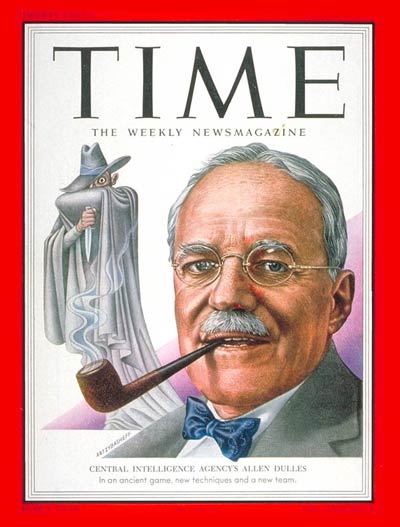
米国中央情報部小史
Short History of the CIA
CIA
director Allen Dulles on the cover of Time magazine in 1953
☆1945 年9月20日、第二次世界大戦が終わって間もなく、トルーマンはOSSを解散させる大統領令に署名した[48]。この分割は数ヶ月しか続かなかった。 1945年末、ジム・フォレスタルとアーサー・ラドフォードが米上院軍事委員会に提出した司令部再編案で、「中央情報局」について初めて公に言及された。 [49] 陸軍情報部のシドニー・マシュビア大佐とエリス・ザカリアス中佐は、ジョセフ・アーネスト・キング艦隊提督の指示のもとで4か月間共同作業を行い、後に中 央情報局となる組織を創設するための最初の草案と実施指令書を作成した[50][51][52]。軍部、国務省、連邦捜査局(FBI)の反対にもかかわら ず[53]、トルーマンは1946年1月に国民情報局(National Intelligence Authority)を設立した[54]。その業務拡張は中央情報部(Central Intelligence Group:CIG)として知られ[55]、CIAの直接の前身となった[56]。
| Immediate
predecessors Further information: Office of Strategic Services  The 140 stars on the CIA Memorial Wall in the CIA headquarters, each representing a CIA officer killed in action  CIA director Allen Dulles on the cover of Time magazine in 1953 During World War II, U.S. intelligence and covert operations were undertaken by the Office of Strategic Services (OSS).[46] Many future CIA officers, including four directors of central intelligence, served in the OSS.[47] On September 20, 1945, shortly after the end of World War II, Truman signed an executive order dissolving the OSS.[48] By October 1945 its functions had been divided between the Departments of State and War. The division lasted only a few months. The first public mention of the "Central Intelligence Agency" appeared on a command-restructuring proposal presented by Jim Forrestal and Arthur Radford to the U.S. Senate Military Affairs Committee at the end of 1945.[49] Army Intelligence agent Colonel Sidney Mashbir and Commander Ellis Zacharias worked together for four months at the direction of Fleet Admiral Joseph Ernest King, and prepared the first draft and implementing directives for the creation of what would become the Central Intelligence Agency.[50][51][52] Despite opposition from the military establishment, the State Department, and the Federal Bureau of Investigation (FBI),[53] Truman established the National Intelligence Authority[54] in January 1946. Its operational extension was known as the Central Intelligence Group (CIG),[55] which was the direct predecessor of the CIA.[56] |
前任者 さらに詳しい情報 戦略サービス局  CIA本部にあるCIAメモリアルウォールの140の星は、それぞれ戦死したCIA職員を表している。  1953年、タイム誌の表紙を飾るアレン・ダレスCIA長官 1945年9月20日、第二次世界大戦が終わって間もなく、トルーマンはOSSを解散させる大統領令に署名した[48]。この分割は数ヶ月しか続かなかっ た。 1945年末、ジム・フォレスタルとアーサー・ラドフォードが米上院軍事委員会に提出した司令部再編案で、「中央情報局」について初めて公に言及された。 [49] 陸軍情報部のシドニー・マシュビア大佐とエリス・ザカリアス中佐は、ジョセフ・アーネスト・キング艦隊提督の指示のもとで4か月間共同作業を行い、後に中 央情報局となる組織を創設するための最初の草案と実施指令書を作成した[50][51][52]。 軍部、国務省、連邦捜査局(FBI)の反対にもかかわらず[53]、トルーマンは1946年1月に国民情報局(National Intelligence Authority)を設立した[54]。その業務拡張は中央情報部(Central Intelligence Group:CIG)として知られ[55]、CIAの直接の前身となった[56]。 |
| Creation The Central Intelligence Agency was created on July 26, 1947, when President Truman signed the National Security Act into law. A major impetus for the creation of the agency was growing tensions with the USSR following the end of World War II.[57] Lawrence Houston, head counsel of the SSU, CIG, and, later CIA, was principal draftsman of the National Security Act of 1947,[58][59][60] which dissolved the NIA and the CIG, and established both the National Security Council and the Central Intelligence Agency.[55][61] In 1949, Houston helped to draft the Central Intelligence Agency Act (Pub. L. 81–110), which authorized the agency to use confidential fiscal and administrative procedures, and exempted it from most limitations on the use of federal funds. The act also exempted the CIA from having to disclose its "organization, functions, officials, titles, salaries, or numbers of personnel employed," and created the program "PL-110" to handle defectors and other "essential aliens" who fell outside normal immigration procedures.[62][63] At the outset of the Korean War, the CIA still only had a few thousand employees, around one thousand of whom worked in analysis. Intelligence primarily came from the Office of Reports and Estimates, which drew its reports from a daily take of State Department telegrams, military dispatches, and other public documents. The CIA still lacked its intelligence-gathering abilities.[64] On August 21, 1950, shortly after, Truman announced Walter Bedell Smith as the new Director of the CIA. The change in leadership took place shortly after the start of the Korean War in South Korea, as the lack of a clear warning to the President and NSC about the imminent North Korean invasion was seen as a grave failure of intelligence.[64] The CIA had different demands placed on it by the various bodies overseeing it. Truman wanted a centralized group to organize the information that reached him.[65][66] The Department of Defense wanted military intelligence and covert action, and the State Department wanted to create global political change favorable to the US. Thus the two areas of responsibility for the CIA were covert action and covert intelligence. One of the main targets for intelligence gathering was the Soviet Union, which had also been a priority of the CIA's predecessors.[65][66][67] U.S. Air Force General Hoyt Vandenberg, the CIG's second director, created the Office of Special Operations (OSO) and the Office of Reports and Estimates (ORE).[66] Initially, the OSO was tasked with spying and subversion overseas with a budget of $15 million (equivalent to $196 million in 2024),[68] the largesse of a small number of patrons in Congress. Vandenberg's goals were much like the ones set out by his predecessor: finding out "everything about the Soviet forces in Eastern and Central Europe – their movements, their capabilities, and their intentions."[69] On June 18, 1948, the National Security Council issued Directive 10/2[70] calling for covert action against the Soviet Union,[71] and granting the authority to carry out covert operations against "hostile foreign states or groups" that could, if needed, be denied by the U.S. government. To this end, the Office of Policy Coordination (OPC) was created inside the CIA.[72] The OPC was unique; Frank Wisner, the head of the OPC, answered not to the CIA Director, but to the secretaries of defense, state, and the NSC. The OPC's actions were a secret even from the head of the CIA. Most CIA stations had two station chiefs, one working for the OSO, and one working for the OPC.[73] The agency was unable to provide sufficient intelligence about the Soviet takeovers of Romania and Czechoslovakia, the Soviet blockade of Berlin, or the Soviet atomic bomb project. In particular, the agency failed to predict the Chinese entry into the Korean War with 300,000 troops.[74][75] The famous double agent Kim Philby was the British liaison to American Central Intelligence.[76] Through him, the CIA coordinated hundreds of airdrops inside the iron curtain, all compromised by Philby. Arlington Hall, the nerve center of CIA cryptanalysis, was compromised by Bill Weisband, a Russian translator and Soviet spy.[77] However, the CIA was successful in influencing the 1948 Italian election in favor of the Christian Democrats.[78] The $200 million Exchange Stabilization Fund (equivalent to $2.6 billion in 2024),[68] earmarked for the reconstruction of Europe, was used to pay wealthy Americans of Italian heritage. Cash was then distributed to Catholic Action, the Vatican's political arm, and directly to Italian politicians. This tactic of using its large fund to purchase elections was frequently repeated in the subsequent years.[79] |
創設 中央情報局は1947年7月26日、トルーマン大統領が国家安全保障法に署名して創設された。諜報機関創設の大きなきっかけとなったのは、第二次世界大戦終結後、ソ連との緊張が高まっていたことであった[57]。 1949年、ヒューストンは中央情報局法(Pub.L. 81-110)の起草に携わり、同法はCIAに機密の財政・行政手続きの使用を認め、連邦資金の使用に関するほとんどの制限を免除するものであった。この 法律はまた、CIAが「組織、機能、職員、役職、給与、雇用されている人員の数」を開示する必要を免除し、通常の入国管理手続きから外れた脱北者やその他 の「必要不可欠な外国人」を扱うためのプログラム「PL-110」を創設した[62][63]。 朝鮮戦争が始まった当初、CIAにはまだ数千人の職員しかおらず、そのうち約1,000人が分析に従事していた。諜報活動は主に報告見積もり局 (Office of Reports and Estimates)から行われ、国務省の電報、軍の通信、その他の公文書を毎日入手して報告を作成していた。CIAはまだ情報収集能力に欠けていた [64]。1950年8月21日、トルーマンはウォルター・ベデル・スミスをCIAの新長官に任命すると発表した。指導者の交代は、韓国で朝鮮戦争が始 まった直後に行われた。北朝鮮の侵攻が差し迫っていることについて大統領とNSCに明確な警告がなかったことが、インテリジェンスの重大な失敗と見なされ たからである[64]。 CIAは、それを監督するさまざまな機関から異なる要求を突きつけられていた。トルーマンは、自分に届く情報を整理するための中央集権的なグループを欲し ていた[65][66]。国防総省は軍事情報と諜報活動を欲し、国務省はアメリカに有利な世界的な政治的変化を作り出したいと考えていた。したがって、 CIAの2つの責任領域は諜報活動と諜報活動であった。情報収集の主なターゲットのひとつはソ連であり、ソ連はCIAの前任者たちにとっても優先事項で あった[65][66][67]。 CIGの2代目長官であったホイト・ヴァンデンバーグ米空軍大将は、特殊作戦室(OSO)と報告・見積もり室(ORE)を創設した[66]。当初、OSO は1,500万ドル(2024年には1億9,600万ドルに相当)の予算で、海外でのスパイ活動と破壊工作を任務としていたが[68]、これは議会の少数 の後援者の大盤振る舞いであった。ヴァンデンバーグの目標は、前任者が掲げたものとよく似ていた。「東欧と中欧のソ連軍について、その動き、能力、意図主 義など、すべてを突き止める」ことであった[69]。 1948年6月18日、国民安全保障会議はソ連に対する秘密行動を求める指令10/2[70]を発し[71]、「敵対的な外国の国家または集団」に対して 秘密作戦を実施する権限を付与したが、必要であればアメリカ政府によって拒否される可能性もあった。この目的のために、政策調整室(OPC)がCIA内部 に創設された[72]。OPCはユニークで、OPCのトップであるフランク・ウィズナーはCIA長官ではなく、国防長官、国務長官、NSCに答えていた。 OPCの行動はCIA長官にも秘密だった。ほとんどのCIA支局には2人の支局長がおり、1人はOSOのために働き、1人はOPCのために働いていた [73]。 CIAは、ソ連によるルーマニアとチェコスロバキアの占領、ソ連によるベルリン封鎖、ソ連の原爆計画について十分な情報を提供することができなかった。特 に、中国が30万の軍隊を引き連れて朝鮮戦争に参戦することを予測できなかった[74][75]。 有名な二重スパイ、キム・フィルビーは、アメリカの中央情報部に対するイギリスの連絡役であった[76]。 彼を通じて、CIAは鉄のカーテン内部での何百もの空中投下を調整したが、そのすべてがフィルビーによって危険にさらされていた。CIAの暗号解読の中枢 であるアーリントン・ホールは、ロシア人翻訳者でソ連のスパイであったビル・ワイズバンドによって漏洩させられた[77]。 しかしCIAは、1948年のイタリアの選挙でキリスト教民主党に有利な影響を与えることに成功した[78]。 ヨーロッパの復興に充てられた2億ドルの為替安定化基金(2024年には26億ドルに相当)は[68]、イタリアの血を引く裕福なアメリカ人への支払いに 使われた。現金はその後、バチカンの政治部門であるカトリック・アクションに分配され、イタリアの政治家に直接支払われた。多額の資金を使って選挙を買収 するというこの戦術は、その後も頻繁に繰り返された[79]。 |
| Korean War See also: History of the Central Intelligence Agency § Korean War At the beginning of the Korean War, CIA officer Hans Tofte claimed to have turned a thousand North Korean expatriates into a guerrilla force tasked with infiltration, guerrilla warfare, and pilot rescue.[80] In 1952 the CIA sent 1,500 more expatriate agents north. Seoul station chief Albert Haney would openly celebrate the capabilities of those agents and the information they sent.[80] In September 1952 Haney was replaced by John Limond Hart, a Europe veteran with a vivid memory for bitter experiences of misinformation.[80] Hart was suspicious of the parade of successes reported by Tofte and Haney and launched an investigation which determined that the entirety of the information supplied by the Korean sources was false or misleading.[81] After the war, internal reviews by the CIA corroborated Hart's findings. The CIA's station in Seoul had 200 officers, but not a single speaker of Korean.[81] Hart reported to Washington that Seoul station could not be salvaged. Loftus Becker, deputy director of intelligence, was sent personally to tell Hart that the CIA had to keep the station open to save face. Becker returned to Washington, D.C., pronouncing the situation to be "hopeless".[81] He then resigned. Air Force Colonel James Kallis stated that CIA director Allen Dulles continued to praise the CIA's Korean force, despite knowing that they were under enemy control.[82] When China entered the war in 1950, the CIA attempted a number of subversive operations in the country, all of which failed due to the presence of double agents. Millions of dollars were spent in these efforts.[83] These included a team of young CIA officers airdropped into China who were ambushed, and CIA funds being used to set up a global heroin empire in Burma's Golden Triangle following a betrayal by another double agent.[83] |
朝鮮戦争 も参照のこと: 中央情報局(CIA)の歴史§朝鮮戦争 朝鮮戦争開戦時、CIAのハンス・トフテは、1000人の北朝鮮駐在員を、潜入、ゲリラ戦、パイロット救出を任務とするゲリラ部隊に仕立て上げたと主張し ていた[80]。1952年、CIAはさらに1500人の駐在員を北に送り込んだ。ソウル支局長のアルバート・ヘイニーは、これらの諜報員の能力と彼らが 送った情報を公然と称賛していた[80]。1952年9月、ヘイニーの後任として、誤報の苦い経験を鮮明に記憶しているヨーロッパの退役軍人ジョン・リモ ンド・ハートが任命された[80]。ハートはトフテとヘイニーが報告した成功のオンパレードに疑念を抱き、調査を開始し、韓国の情報源から提供された情報 のすべてが虚偽または誤解を招くものであると断定した[81]。CIAのソウル支局には200人の局員がいたが、韓国語を話せる局員は1人もいなかった [81]。情報部副部長のロフタス・ベッカーが人格的に派遣され、CIAは面子を保つためにソウル支局を存続させなければならないとハートに伝えた。ベッ カーはワシントンD.C.に戻り、状況は「絶望的」であると宣告した[81]。ジェームズ・カリス空軍大佐は、CIA長官のアレン・ダレスは、CIAの韓 国軍が敵の支配下にあることを知っていたにもかかわらず、賞賛し続けたと述べている[82]。 1950年に中国が参戦すると、CIAは同国で数多くの破壊活動を試みたが、二重スパイの存在によりすべて失敗に終わった。これらの活動には数百万ドルが 費やされた[83]。その中には、中国に空挺降下したCIAの若い将校のチームが待ち伏せされたことや、別の二重スパイによる裏切りの後、ビルマのゴール デントライアングルで世界的なヘロイン帝国を設立するためにCIAの資金が使われたことなどが含まれる[83]。 |
| 1953 Iranian coup d'état Main article: 1953 Iranian coup d'état 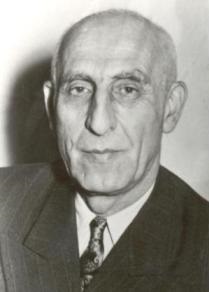 The CIA aided the British in overthrowing Iranian Prime Minister Mohammad Mosaddegh in 1953 In 1951, Mohammad Mosaddegh, a member of the National Front, was elected Iranian prime-minister.[84] As prime minister, he nationalized the Anglo-Persian Oil Company which his predecessor had supported. The nationalization of the British-funded Iranian oil industry, including the largest oil refinery in the world, was disastrous for Mosaddegh. A British naval embargo closed the British oil facilities, which Iran had no skilled workers to operate. In 1952, Mosaddegh resisted the royal refusal to approve his Minister of War and resigned in protest. The National Front took to the streets in protest. Fearing a loss of control, the military pulled its troops back five days later, and Shah Mohammad Reza Pahlavi gave in to Mosaddegh's demands. Mosaddegh quickly replaced military leaders loyal to the Shah with those loyal to him, giving him personal control over the military. Given six months of emergency powers, Mosaddegh unilaterally passed legislation. When that six months expired, his powers were extended for another year. In 1953, Mossadegh dismissed parliament and assumed dictatorial powers. This power grab triggered the Shah to exercise his constitutional right to dismiss Mosaddegh. Mosaddegh launched a military coup, and the Shah fled the country. Under CIA Director Allen Dulles, Operation Ajax was put into motion. Its goal was to overthrow Mossadegh with military support from General Fazlollah Zahedi and install a pro-western regime headed by the Shah of Iran. Kermit Roosevelt Jr. oversaw the operation in Iran.[85] On August 16, a CIA paid mob led by Ayatollah Ruhollah Khomeini would spark what a U.S. embassy officer called "an almost spontaneous revolution"[86] but Mosaddegh was protected by his new inner military circle, and the CIA had been unable to gain influence within the Iranian military. Their chosen man, former General Fazlollah Zahedi, had no troops to call on.[87] After the failure of the first coup, Roosevelt paid demonstrators to pose as communists and deface public symbols associated with the Shah. This August 19 incident helped foster public support of the Shah and led gangs of citizens on a spree of violence intent on destroying Mossadegh.[88] An attack on his house forced Mossadegh to flee. He surrendered the next day, and his coup came to an end.[89] |
1953年イランのクーデター 主な記事 1953年イランのクーデター  CIAは1953年、イランのモハンマド・モサデグ首相を打倒するためにイギリスを支援した。 1951年、国民戦線のメンバーであったモハンマド・モサデグはイランの首相に選出された[84]。首相として彼は、前任者が支援していたアングロ・ペル シャ石油会社を国有化した。世界最大の製油所を含む、イギリスが出資するイランの石油産業のナショナリズムは、モサデグにとって悲惨なものであった。イギ リス海軍の禁輸措置によってイギリスの石油施設は閉鎖され、イランには操業する熟練労働者がいなかった。1952年、モサデグは王室が陸軍大臣を承認しな いことに抵抗し、抗議のために辞任した。国民戦線は抗議のため街頭に繰り出した。統制力の喪失を恐れた軍は5日後に軍を引き揚げ、国王モハンマド・レザ・ パフラヴィはモサデグの要求を呑んだ。モサデグはすぐに、国王に忠誠を誓う軍の指導者たちを自分に忠誠を誓う者たちと入れ替え、軍を人格的に支配するよう になった。モサデグは6ヶ月間の非常事態権限を与えられ、一方的に法案を可決した。その半年が過ぎると、モサデグの権限はさらに1年延長された。1953 年、モサデグは議会を罷免し、独裁権力を掌握した。この権力掌握が引き金となり、国王はモサデグを罷免する憲法上の権利を行使した。モサデグは軍事クーデ ターを起こし、国王は国外に逃亡した。 CIA長官アレン・ダレスのもと、エイジャックス作戦が発動された。その目的は、ファズロッラー・ザヘディ将軍の軍事的支援を受けてモサデグを打倒し、イ ランのシャーを首班とする親欧米政権を樹立することだった。カーミット・ルーズベルト・ジュニアがイランでの作戦を監督していた[85]。8月16日、ホ メイニ師率いるCIAが雇った暴徒が、アメリカ大使館職員が「ほとんど自然発生的な革命」と呼ぶ事態を引き起こすことになる[86]。最初のクーデターが 失敗した後、ルーズベルトはデモ隊に共産主義者を装い、国王に関連する公共のシンボルを汚すよう金を支払った[87]。この8月19日の事件は、国民の シャー支持を助長し、市民の暴力団をモサデグを破壊する意図主義に走らせた[88]。翌日、モサデグは降伏し、クーデターは終結した[89]。 |
| 1954 Guatemalan coup d'état Main article: 1954 Guatemalan coup d'état 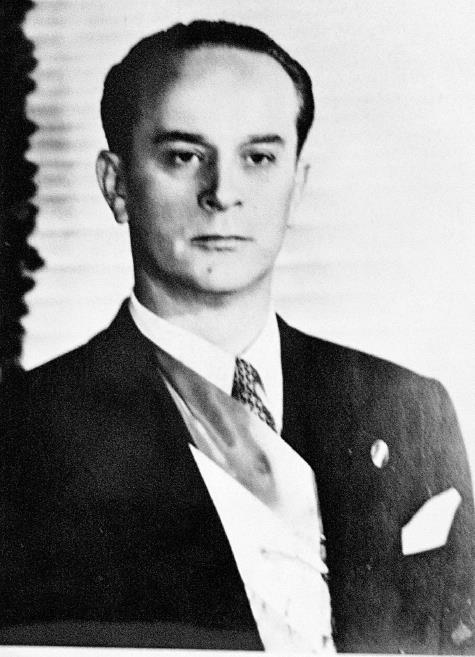 When democratically elected President Jacobo Árbenz attempted a modest redistribution of land in Guatemala, he was overthrown in the 1954 Guatemalan coup d'état. The return of the Shah to power, and the impression that an effective CIA had been able to guide that nation to friendly and stable relations with the West, triggered planning for Operation PBSuccess, a plan to overthrow Guatemalan President Jacobo Arbenz.[90] The plan was exposed in major newspapers before it happened after a CIA agent left plans for the coup in his Guatemala City hotel room.[91] The Guatemalan Revolution of 1944–54 overthrew the U.S. backed dictator Jorge Ubico and brought a democratically elected government to power. The government began an ambitious agrarian reform program which sought to grant land to millions of landless peasants. The program threatened the land holdings of the United Fruit Company, who lobbied for a coup by portraying these reforms as communist.[92][93][94][95] On June 18, 1954, Carlos Castillo Armas led 480 CIA-trained men across the border from Honduras into Guatemala. The weapons had also come from the CIA.[96] The CIA mounted a psychological campaign to convince the Guatemalan people and government that Armas's victory was a fait accompli. Its largest aspect was a radio broadcast entitled "The Voice of Liberation" which announced that Guatemalan exiles led by Castillo Armas were shortly about to liberate the country.[96] On June 25, a CIA plane bombed Guatemala City, destroying the government's main oil reserves. Árbenz ordered the army to distribute weapons to local peasants and workers.[97] The army refused, forcing Jacobo Árbenz's resignation on June 27, 1954. Árbenz handed over power to Colonel Carlos Enrique Diaz.[97] The CIA then orchestrated a series of power transfers that ended with the confirmation of Castillo Armas as president in July 1954.[97] Armas was the first in a series of military dictators that would rule the country, leading to the brutal Guatemalan Civil War from 1960 to 1996, in which some 200,000 people were killed, mostly by the U.S.-backed military.[102] |
1954年グアテマラ・クーデター 主な記事 1954年グアテマラ・クーデター  民主的に選出されたハコボ・アルベンツ大統領がグアテマラでささやかな土地再分配を試みたところ、1954年のグアテマラ・クーデターで打倒された。 国王が政権に復帰し、有能なCIAがその国民を西側諸国との友好的で安定した関係に導くことができたという印象が、グアテマラ大統領ハコボ・アルベンスを 打倒する計画であるPBSuccess作戦を計画するきっかけとなった[90]。この計画は、CIAエージェントがグアテマラシティのホテルの部屋にクー デターの計画書を残したことから、実現する前に主要紙に暴露された[91]。 1944年から54年にかけてのグアテマラ革命は、アメリカの支援を受けた独裁者ホルヘ・ウビコを打倒し、民主的に選出された政権を誕生させた。政府は野 心的な農地改革プログラムを開始し、何百万人もの土地を持たない農民に土地を与えようとした。このプログラムはユナイテッド・フルーツ・カンパニーの土地 保有を脅かし、ユナイテッド・フルーツ・カンパニーはこれらの改革を共産主義的なものとしてクーデターを働きかけた[92][93][94][95]。 1954年6月18日、カルロス・カスティーヨ・アルマスは480人のCIAに訓練された男たちを率いてホンジュラスからグアテマラへと国境を越えた。武 器もCIAから調達したものだった[96]。CIAはグアテマラの人民と政府にアルマスの勝利は既成事実であると信じ込ませるための心理作戦を展開した。 その最大の側面は「解放の声」と題されたラジオ放送で、カスティーリョ・アルマス率いるグアテマラ亡命者がまもなく国を解放すると発表した[96]。6月 25日、CIAの飛行機がグアテマラ・シティを爆撃し、政府の主要な石油備蓄を破壊した。アルベンスは軍に、地元の農民や労働者に武器を配布するよう命じ た[97]。軍はこれを拒否し、1954年6月27日にハコボ・アルベンスは辞任を余儀なくされた。アルベンスはカルロス・エンリケ・ディアス大佐に政権 を譲った[97]。その後CIAは一連の権力移譲を画策し、1954年7月にカスティーリョ・アルマスが大統領に就任した。 |
| Syria Main article: CIA activities in Syria 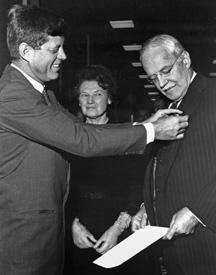 President John F. Kennedy presenting the National Security Medal to Allen Dulles on November 28, 1961 In 1949, Colonel Adib Shishakli rose to power in Syria in a CIA-backed coup. Four years later, he would be overthrown by the military, Ba'athists, and communists. The CIA and MI6 started funding right-wing members of the military but suffered a huge setback in the aftermath of the Suez Crisis. CIA Agent Rocky Stone, who had played a minor role in the 1953 Iranian coup d'état, was working at the Damascus embassy as a diplomat but was the station chief. Syrian officers on the CIA dole quickly appeared on television stating that they had received money from "corrupt and sinister Americans" "in an attempt to overthrow the legitimate government of Syria."[103] Syrian forces surrounded the embassy and rousted Agent Stone, who confessed and subsequently made history as the first American diplomat expelled from an Arab nation. This strengthened ties between Syria and Egypt, helping establish the United Arab Republic, and poisoning the well for the US for the foreseeable future.[103] |
シリア 主な記事 シリアにおけるCIAの活動  1961年11月28日、ジョン・F・ケネディ大統領がアレン・ダレスにナショナリズム勲章を授与した。 1949年、CIAの支援を受けたクーデターにより、アディブ・シシャクリ大佐がシリアで権力を握った。4年後、彼は軍、バアス主義者、共産主義者によっ て打倒された。CIAとMI6は軍の右派メンバーに資金を提供し始めたが、スエズ危機の余波で大きな苦悩を味わった。CIAエージェントのロッキー・ス トーンは、1953年のイランのクーデターで小さな役割を果たしたが、ダマスカス大使館で外交官として働いていたが、支局長だった。シリア軍は大使館を包 囲し、ストーン捜査官を追い出し、ストーン捜査官は自白し、その後アラブ国民から追放された最初のアメリカ人外交官として歴史に名を刻んだ。これによりシ リアとエジプトの結びつきが強まり、アラブ連合共和国の樹立に貢献し、アメリカにとっては当分の間、井戸に毒を盛ることになった[103]。 |
| Indonesia Main article: CIA activities in Indonesia See also: Indonesian mass killings of 1965–66 The United States was suspicious of Sukarno, Indonesia's president, because of his declaration of neutrality in the Cold War.[104] After Sukarno hosted the Bandung Conference, promoting the Non-Aligned Movement, the Eisenhower White House responded with NSC 5518 authorizing "all feasible covert means" to move Indonesia into the Western sphere.[105] The U.S. had no clear policy on Indonesia. Eisenhower sent his special assistant for security operations, F. M. Dearborn Jr., to Jakarta. His report that there was high instability, and that the US lacked stable allies, reinforced the domino theory. Indonesia suffered from what he described as "subversion by democracy".[106] The CIA decided to attempt another military coup in Indonesia, where the Indonesian military was trained by the US, had a strong professional relationship with the US military, had a pro-American officer corps that strongly supported their government, and a strong belief in civilian control of the military, instilled partly by its close association with the US military.[107] On September 25, 1957, Eisenhower ordered the CIA to start a revolution in Indonesia with the goal of regime change. Three days later, Blitz, a Soviet-controlled weekly in India,[108] reported that the US was plotting to overthrow Sukarno. The story was picked up by the media in Indonesia. One of the first parts of the operation was an 11,500-ton US Navy ship landing at Sumatra, delivering weapons for as many as 8,000 potential revolutionaries.[109] In support of the Revolutionary Government of the Republic of Indonesia-Permesta Movement, formed by dissident military commanders in Central Sumatera and North Sulawesi with the aim of overthrowing the Sukarno regime, a B-26 piloted by CIA agent Allen Lawrence Pope attacked Indonesian military targets in April and May 1958.[110] The CIA described the airstrikes to the President as attacks by "dissident planes." Pope's B-26 was shot down over Ambon, Indonesia on May 18, 1958, and he bailed out. When he was captured, the Indonesian military found his personnel records, after-action reports, and his membership card for the officer's club at Clark Field. On March 9, Foster Dulles, the Secretary of State, and brother of DCI Allen Dulles made a public statement calling for a revolt against communist despotism under Sukarno. Three days later, the CIA reported to the White House that the Indonesian Army's actions against the CIA-supported revolution were suppressing communism.[111] After Indonesia, Eisenhower displayed mistrust of both the CIA and its director, Allen Dulles. Dulles too displayed mistrust of the CIA itself. Abbot Smith, a CIA analyst who later became chief of the Office of National Estimates, said, "We had constructed for ourselves a picture of the USSR, and whatever happened had to be made to fit into this picture. Intelligence estimators can hardly commit a more abominable sin." On December 16, Eisenhower received a report from his intelligence board of consultants that said the agency was "incapable of making objective appraisals of its own intelligence information as well as its own operations."[112] |
インドネシア 主な記事 インドネシアにおけるCIAの活動 以下も参照のこと: 1965-66年にインドネシアで発生した大量殺人事件 スカルノがバンドン会議を主催し、非同盟運動を推進した後、アイゼンハワー・ホワイトハウスはNSC5518で、インドネシアを西側圏に移行させるための「実行可能なあらゆる秘密手段」を承認した[105]。 アメリカはインドネシアについて明確な政策を持っていなかった。アイゼンハワーは安全保障作戦担当特別補佐官F・M・ディアボーン・ジュニアをジャカルタ に派遣した。彼の報告によると、インドネシアには高い不安定性があり、アメリカには安定した同盟国がないということで、ドミノ理論が補強された。インドネ シア軍はアメリカによって訓練され、米軍と強い専門的関係を持ち、政府を強く支持する親米的な将校団を持ち、米軍との緊密な関係によって部分的に植え付け られた軍の文民統制に対する強い信念を持っていた[107]。 1957年9月25日、アイゼンハワーは政権交代を目的としてインドネシアで革命を起こすようCIAに命じた。その3日後、インドのソ連支配下の週刊誌 『ブリッツ』[108]は、アメリカがスカルノ打倒を企てていると報じた。この記事はインドネシアのメディアにも取り上げられた。作戦の最初の部分は、 11,500トンのアメリカ海軍の船がスマトラ島に上陸し、8,000人もの潜在的な革命家のために武器を届けることであった[109]。 スカルノ政権を打倒する目的で中央スマトラと北スラウェシの反体制派軍司令官によって結成されたインドネシア共和国革命政府=ペルメスタ運動を支援するた め、CIA諜報員アレン・ローレンス・ポープが操縦するB-26が1958年4月と5月にインドネシア軍の標的を攻撃した[110]。CIAは大統領に空 爆を「反体制派機」による攻撃と説明した。ポープのB-26は1958年5月18日にインドネシアのアンボン上空で撃墜され、彼は脱出した。彼が捕らえら れたとき、インドネシア軍は彼の人事記録、事後報告書、クラーク・フィールドの将校クラブの会員証を発見した。3月9日、フォスター・ダレス国務長官とア レン・ダレス副長官の弟は、スカルノの共産主義専制主義に対する反乱を呼びかける公式声明を発表した。その3日後、CIAはホワイトハウスに、CIAが支 援した革命に対するインドネシア軍の行動が共産主義を抑圧していると報告した[111]。 インドネシアの後、アイゼンハワーはCIAとその長官であるアレン・ダレスの双方に不信感を示した。ダレスもまたCIAそのものに不信感を示していた。 CIAの分析官で、後にナショナリズム見積もり局のチーフとなったアボット・スミスは、「われわれは、ソ連に対するイメージを自分たちのために構築してお り、何が起ころうと、このイメージに適合させなければならなかった」と述べている。諜報推定担当者は、これ以上忌まわしい罪を犯すことはできない」と述べ ている。12月16日、アイゼンハワーは情報諮問委員会から、情報機関は「自らの作戦だけでなく、自らの情報情報についても客観的な評価を下すことができ ない」とする報告書を受け取った[112]。 |
| Democratic Republic of the Congo Main article: CIA activities in the Democratic Republic of the Congo The Congo became independent from Belgium in 1960.[113] The United States feared that its new prime minister, Patrice Lumumba, was susceptible to Soviet influence, so the CIA supported Joseph Mobutu in organizing a coup that deposed Lumumba on September 14, 1960.[114] Lumumba was assassinated by his Congolese and Belgian enemies in 1961, with CIA acquiescence.[115] The CIA continued to back the Mobutu regime throughout the Cold War, despite its corruption, mismanagement, and human rights abuses.[116] |
コンゴ民主共和国 主な記事 コンゴ民主共和国におけるCIAの活動 コンゴは1960年にベルギーから独立した[113]。アメリカは新首相のパトリス・ルムンバがソ連の影響を受けやすいことを恐れ、CIAはジョセフ・モ ブツを支援してクーデターを組織し、1960年9月14日にルムンバを退陣させた。[114]ルムンバは1961年にコンゴとベルギーの敵によって暗殺さ れたが、CIAはその腐敗、不始末、人権侵害にもかかわらず、冷戦期を通じてモブツ政権を支援し続けた[115]。 |
| 1960 U-2 incident Main article: 1960 U-2 incident 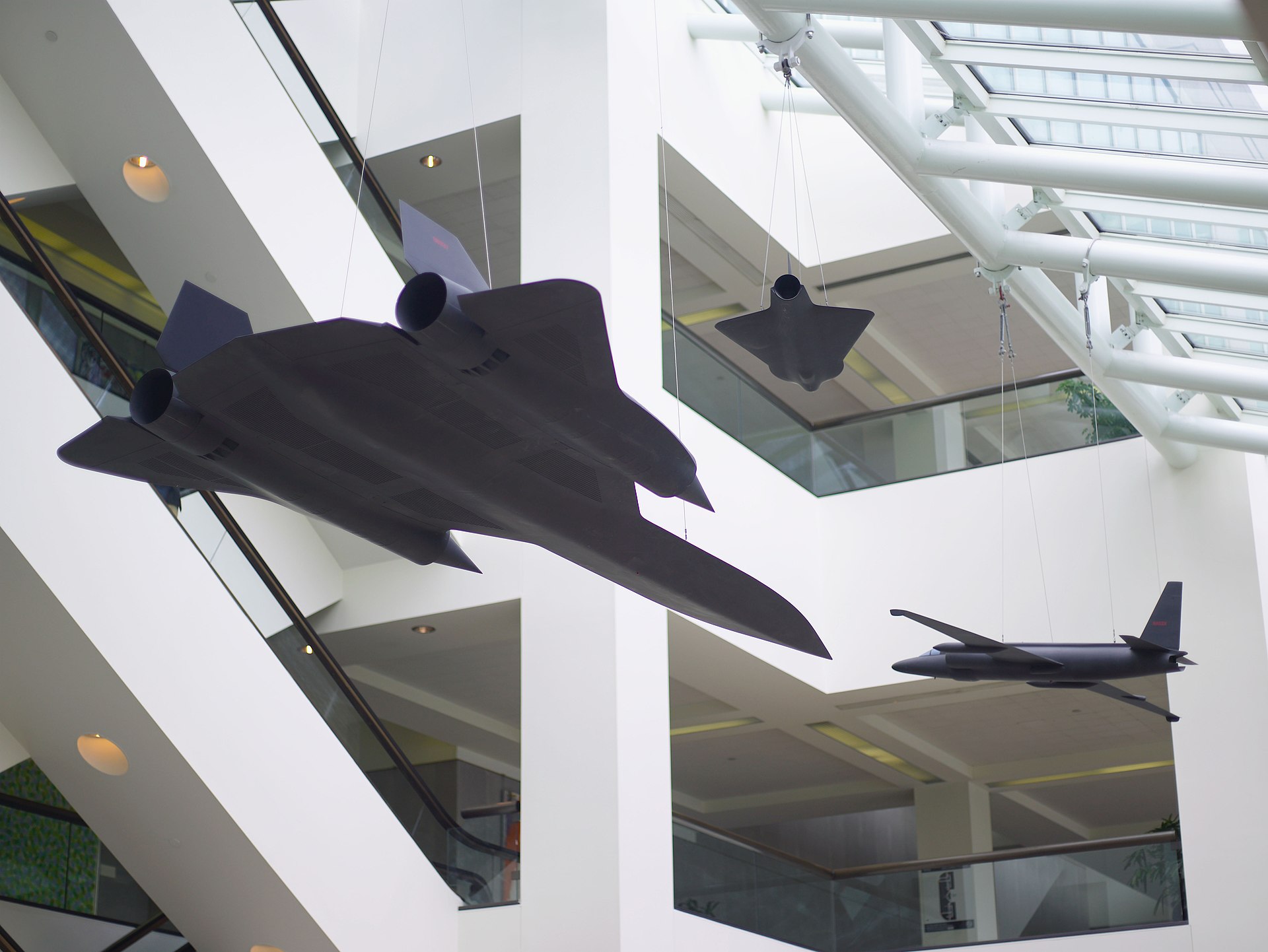 Suspended from the ceiling of the glass-enclosed atrium: three models of the U-2, Lockheed A-12, and D-21 drone. These models are exact replicas at one-sixth scale of the real planes. All three had photographic capabilities. The U-2 was one of the first espionage planes developed by the CIA. The A-12 set unheralded flight records. The D-21 drone was one of the first crewless aircraft ever built. Lockheed Martin donated all three models to the CIA. After the bomber gap came the missile gap. Eisenhower wanted to use the U-2 to disprove the Missile Gap, but he had banned U-2 overflights of the USSR after meeting Secretary Khrushchev at Camp David. Another reason the President objected to the use of the U-2 was that, in the nuclear age, the intelligence he needed most was on their intentions, without which, the US would face a paralysis of intelligence. He was particularly worried that U-2 flights could be seen as preparations for first-strike attacks. He had high hopes for an upcoming meeting with Khrushchev in Paris. Eisenhower finally gave in to CIA pressure to authorize a 16-day window for flights, which was extended an additional six days because of poor weather. On May 1, 1960, the Soviet Air Forces shot down a U-2 flying over Soviet territory. To Eisenhower, the ensuing coverup destroyed his perceived honesty and his hope of leaving a legacy of thawing relations with Khrushchev. Eisenhower later said that the U-2 coverup was the greatest regret of his presidency.[117]: 160 |
1960年 U-2事件 主な記事 1960年 U-2事件  ガラス張りのアトリウムの天井から吊るされているのは、U-2、ロッキードA-12、D-21ドローンの3つの模型だ。これらの模型は実機の6分の1の縮 尺で正確に再現されている。3機とも写真撮影が可能だった。U-2はCIAが開発した最初のスパイ機のひとつだ。A-12は前人未到の飛行記録を打ち立て た。D-21ドローンは、これまでに製造された最初のクルーレス航空機のひとつだった。ロッキード・マーチンは3機種すべてをCIAに寄贈した。 爆撃機の空白の後にはミサイルの空白が待っていた。アイゼンハワーはミサイル・ギャップを反証するためにU-2を使いたかったが、キャンプ・デービッドで フルシチョフ長官と会談した後、U-2によるソ連上空飛行を禁止していた。大統領がU-2の使用に反対したもう一つの理由は、核時代において大統領が最も 必要とする情報は、彼らの意図主義であり、それがなければアメリカは情報の麻痺に直面することになるからであった。彼は特に、U-2の飛行が先制攻撃の準 備と見られることを懸念していた。彼はパリでのフルシチョフとの会談に大きな期待を寄せていた。アイゼンハワーはついにCIAの圧力に屈し、16日間の飛 行を許可したが、天候不良のためさらに6日間延長された。1960年5月1日、ソ連空軍はソ連領上空を飛行していたU-2を撃墜した。アイゼンハワーに とって、その後の隠蔽工作は、彼の誠実さと、フルシチョフとの関係融和という遺産を残すという希望を打ち砕いた。アイゼンハワーは後に、U-2の隠蔽は大 統領在任中最大の後悔であったと語っている[117]: 160 |
| Dominican Republic In the Dominican Republic, the authoritarian regime of Generalissimo Rafael Trujillo lasted more than three decades, and enjoyed considerable U.S support, as Trujillo was very anti-communist and opposed the new communist regime in Cuba led by Castro. Early on though, Trujillo acted more independently from the U.S, prioritizing Dominican interests over just doing the will of Washington, especially on a domestic aspect,[118] compared to other more submissive regimes, like Somoza in Nicaragua.[119] Then, the United States severed diplomatic relations with the nation in August 1960, after a failed plot against Venezuelan President Rόmulo Betancourt earlier that year was uncovered to be personally funded and orchestrated by the Trujillo regime's foreign agents. This proved o be a big liability for the U.S, undermining its diplomatic credibility and standing with other nations since it could expose the country's hypocrisy on their agenda of expanding and preserving democracy across the world. The CIA's Special Group armed Dominican dissidents to assassinate Trujillo, but President Kennedy paused the plan when he came into power, and resorted to negotiating with the regime. Kennedy allowed the distribution of four additional machine guns, and Trujillo was later assassinated in a conspiracy by army officers funded by the CIA on May 30, 1961.[120] In the aftermath, Robert Kennedy wrote that the CIA had succeeded where it had failed many times in the past, but in the face of that success, it was caught flatfooted, having failed to plan what to do next.[117] Because of this, the country plunged into chaos, as the remnants of the regime tried desperately to hold on to power, with Ramfis Trujillo, the son of the dictator, returning to the country from Paris to try and restore the old order. This, however, would eventually fail, as a military rebellion on November 19, 1961 foiled a planned coup attempt by the Trujillo brothers (codenamed Operaciόn Luz Verde), and forced the family to flee the country to Spain, marking the end of the 31 year long regime and leaving Joaquín Balaguer, a close friend and top politician of the old regime, as the sole man in power. The United States, for its part, would keep a close eye on the D.R under the pretext of 'preventing another Cuba'. In 1963, Juan Bosch, an intellectual and key opponent to the Trujillo regime, ascended to the presidency. Bosch wasn't exactly left-leaning, but he certainly wasn't in good terms with the U.S either. Bosch had little to no support in the military, still full of Trujillistas and conservative hardliners, since he wanted to put a check on its power and put it under civilian control, and the liberal 1963 constitution Bosch implemented was the last straw for the military and the Dominican oligarchy, as they immediately started plotting against Bosch. The CIA, at odds with president Kennedy and acting semi-independently, at the very least, knew about the situation and the upcoming coup against Bosch, and maybe even helped orchestrate it without Kennedy's direct approval.[121] Nevertheless, Bosch was overthrown in a military coup on September 25h, 1963, barely seven months into his presidency. Kennedy condemned the coup, and refused to recognize the new military triumvirate, but after he was assassinated in November, the new president, Lyndon B. Johnson, recognized the new junta and allied itself with it. On April 24, 1965, many elements of the military, particularly soldiers and young officers, launched a counter-coup against the military triumvirate, in what was known as the April Revolution, which would later turn into a wider civil war, which the junta, already increasingly unpopular, was losing quickly, much to the panic of the CIA and the White House. Generals still loyal to the triumvirate, called loyalists, quickly losing ground and on the verge of collapse, went to the U.S and asked for military assistance, and Lyndon B. Johnson, certain that the rebels, called the constitutionalists, were actually communists, sent 42,000 troops to invade the DR on April 28, under the pretext of protecting foreign lives, but actually intervening to keep their influence in the D.R present and prevent a revolutionary victory, which could undermine D.C's business and political interests. The CIA heavily facilitated the intervention with intelligence and arming pro-loyalist factions.[122] The constitutionalists fought the U.S invasion fiercely, but by summer, the U.S had prevented the full victory of the constitutionalists, but they also failed to crush the rebellion outright, making the war a bloody stalemate, as a political settlement was reached, which ended in elections held the next year, in 1966, which Balaguer won, becoming president for the next 12 years and an important political figure in the country for the remainder of the century. |
ドミニカ共和国 ドミニカ共和国では、ラファエル・トルヒージョ大将の独裁政権が30年以上続き、トルヒージョは反共産主義者であり、カストロが率いるキューバの新しい共 産主義政権に反対していたため、米国から多大な支援を受けていた。しかし、当初はトルヒージョは米国からより独立した行動を取り、特に国内問題において は、ニカラグアのソモサ政権のようなより従属的な政権と比べて、ワシントンの意向に従うよりもドミニカ共和国の利益を優先していた[118]。[119] その後、1960年8月、ベネズエラのロムロ・ベタンコート大統領に対する暗殺計画が、トルヒージョ政権の外国工作員によって個人的に資金提供され、計画 されたものであることが発覚し、米国はドミニカ共和国との外交関係を断絶した。これは、世界中に民主主義を拡大・維持するという米国の政策の偽善を露呈す るものであり、米国の外交的信頼性と他国からの評価を大きく損なう結果となった。CIA の特別部隊は、トルヒージョを暗殺するためにドミニカ共和国の反体制派に武器を供給したが、ケネディ大統領は就任後、この計画を一時中断し、政権との交渉 に踏み切った。ケネディは 4 挺の機関銃の追加供給を許可し、1961 年 5 月 30 日、CIA の資金援助を受けた陸軍将校たちによる陰謀で、トルヒージョは暗殺された[120]。その後、ロバート・ケネディは、CIA はこれまで何度も失敗してきたことを今回初めて成功させたが、その成功に直面して、次の行動計画を立てなかったため、手も足も出なかったと記している。 [117] このため、政権の残党が権力の維持に必死になり、独裁者の息子であるラムフィス・トルヒージョがパリから帰国して旧体制の復活を試みたため、国は混乱に 陥った。しかし、1961年11月19日に起きた軍事反乱が、トゥリッリョ兄弟が計画したクーデター(コードネーム「オペラシオン・ルス・ベルデ」)を阻 止し、家族はスペインへ逃亡を余儀なくされた。これにより、31年間続いた政権は終焉を迎え、旧政権の親しい友人であり主要政治家だったホアキン・バ ジェールが唯一の権力者となった。 アメリカ合衆国は、ドミニカ共和国を「もう一つのキューバを防ぐ」という名目で監視を強化した。1963年、トルヒージョ政権の主要な反対派で知識人のフ アン・ボッシュが大統領に就任した。ボッシュは左派ではなかったが、アメリカとも良好な関係ではなかった。彼は軍部からほとんど支持を得ていなかった。軍 部は依然としてトゥリッリスタと保守派の硬派で占められており、ボッシュは軍部の権力を抑制し、文民統制下に置こうとしていたからだ。ボッシュが施行した 1963年の自由主義的な憲法は、軍部とドミニカ共和国の寡頭政治層にとって最後の straw となり、彼らはすぐにボッシュに対するクーデターを計画し始めた。CIAはケネディ大統領と対立し、少なくとも半独立的に行動していたため、ボッシュに対 するクーデター計画を知っていただけでなく、ケネディの直接の承認なしにクーデターを画策した可能性もある。[121] いずれにせよ、ボッシュは1963年9月25日、大統領就任からわずか7ヶ月で軍事クーデターにより打倒された。ケネディはクーデターを非難し、新たな軍 事三頭政治を承認しなかったが、彼が11月に暗殺されると、新大統領のリンドン・B・ジョンソンは新たな軍事政権を承認し、同盟を結んだ。 1965年4月24日、軍部の多くの要素、特に兵士や若手将校たちが、軍事三頭政治に対する反クーデター、いわゆる「4月革命」を起こした。この革命はそ の後、より広範な内戦へと発展し、すでに人気が低下していた軍事政権は、CIA やホワイトハウスをパニックに陥れるほど、急速に敗北していった。三頭政治に忠実な将軍たち(忠実派)は、急速に勢力を失い崩壊寸前となり、米国に軍事支 援を要請した。リンドン・B. ジョンソンは、反乱軍(憲法派)が実際には共産主義者だと確信し、4月28日に「外国人の生命保護」を口実として4万2000人の兵力をドミニカ共和国に 派遣した。しかし、その真の目的は、ドミニカ共和国における影響力を維持し、革命の勝利を阻止することで、ワシントンのビジネスと政治的利益を損なうこと を防ぐことだった。CIAは、情報提供と親政府派勢力への武器供与を通じて介入を積極的に支援した。[122] 憲法派はアメリカ軍の侵攻に激しく抵抗したが、 しかし、夏までにアメリカは憲法派の完全な勝利を阻止したものの、反乱を完全に鎮圧することもできず、戦争は血なまぐさい膠着状態に陥った。その後、政治 的合意が成立し、翌年1966年に選挙が行われ、バラグエルが勝利し、次の12年間大統領を務め、世紀の残りの期間、同国で重要な政治家として活躍した。 |
| Bay of Pigs Main article: Bay of Pigs invasion See also: CIA assassination attempts on Fidel Castro See also: History of the Central Intelligence Agency § Cuba 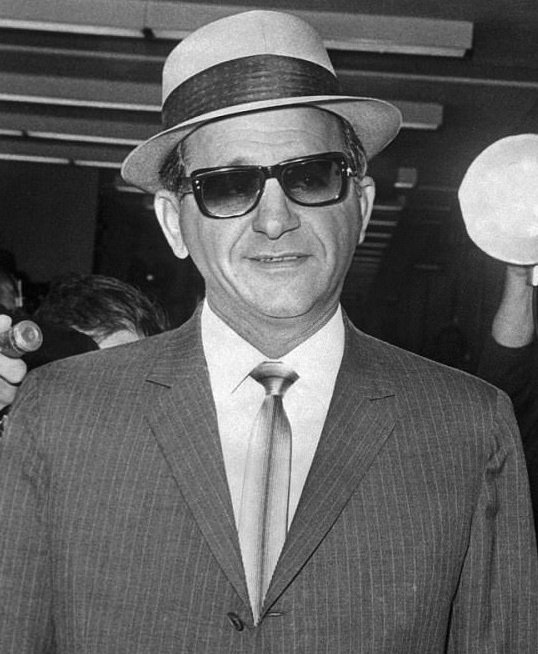 Sam Giancana (pictured), Santo Trafficante, and others, who were recruited by the CIA to assassinate Fidel Castro in Cuba[123] The CIA welcomed Fidel Castro on his visit to Washington, D.C., and gave him a face-to-face briefing. The CIA hoped that Castro would bring about a friendly democratic government and planned to support his government with money and guns. By December 11, 1959, however, a memo reached the DCI's desk recommending Castro's "elimination." Dulles replaced the word "elimination" with "removal," and set the scheme into action. By mid-August 1960, Dick Bissell sought, with the full backing of the CIA, to hire the Mafia to assassinate Castro.[124] The Bay of Pigs Invasion was a failed military invasion of Cuba undertaken by the CIA-sponsored paramilitary group Brigade 2506 on April 17, 1961. A counter-revolutionary military, trained and funded by the CIA, Brigade 2506 fronted the armed wing of the Democratic Revolutionary Front (DRF) and intended to overthrow Castro's increasingly communist government. Launched from Guatemala, the invading force was defeated within three days by the Cuban Revolutionary Armed Forces, under Castro's direct command. US President Dwight D. Eisenhower was concerned at the direction Castro's government was taking, and in March 1960, Eisenhower allocated $13.1 million to the CIA to plan his overthrow. The CIA proceeded to organize the operation with the aid of various Cuban counter-revolutionary forces, training Brigade 2506 in Guatemala. Over 1,400 paramilitaries set out for Cuba by boat on April 13 for a marine invasion. Two days later on April 15, eight CIA-supplied B-26 bombers attacked Cuban airfields. On the night of April 16, the land invasion began in the Bay of Pigs, but by April 20, the invaders finally surrendered. The failed invasion strengthened the position of Castro's leadership as well as his ties with the USSR. This led eventually to the events of the Cuban Missile Crisis of 1962. The invasion was a major embarrassment for US foreign policy. The Taylor Board was commissioned to determine what went wrong in Cuba. The Board came to the same conclusion that the Jan '61 President's Board of Consultants on Foreign Intelligence Activities had concluded, and many other reviews prior, and to come, that Covert Action had to be completely isolated from intelligence and analysis. The Inspector General of the CIA investigated the Bay of Pigs. He concluded that there was a need to improve the organization and management of the CIA drastically. |
ピッグス湾 主な記事:ピッグス湾侵攻 関連項目:CIAによるフィデル・カストロ暗殺計画 関連項目:中央情報局の歴史 § キューバ  サム・ジャンカーナ(写真)、サント・トラフィカンテなど、キューバでフィデル・カストロを暗殺するためにCIAに採用された人物たち[123] CIA は、ワシントン D.C. を訪問したフィデル・カストロを歓迎し、直接説明を行った。CIA は、カストロが友好的な民主政権を樹立することを期待し、その政権を資金と武器で支援する計画を立てていた。しかし、1959年12月11日までに、カス トロの「排除」を推奨するメモが DCI の机に届いた。ダレスは「排除」という言葉を「排除」に置き換え、この計画を実行に移した。1960年8月中旬、ディック・ビスセルはCIAの全面的な支 援を受けて、カストロを暗殺するためにマフィアを雇おうとした[124]。 ピッグス湾侵攻は、1961年4月17日にCIAが支援する準軍事組織「第2506旅団」によって実行されたキューバへの軍事侵攻で、失敗に終わった。 CIAによって訓練され資金提供を受けた反革命軍事組織である第2506旅団は、民主革命戦線(DRF)の武装部門を装い、カストロのますます共産主義化 が進む政府を打倒する目的で活動していた。グアテマラから出撃した侵攻部隊は、カストロの直接指揮下にあるキューバ革命軍によって3日以内に敗北した。ア メリカ合衆国大統領ドワイト・D・アイゼンハワーは、カストロ政権の動向に懸念を抱き、1960年3月にCIAに1,310万ドルを拠出、カストロの打倒 計画を立案させた。CIAは、キューバの反革命勢力と協力して作戦を組織し、グアテマラで第2506旅団を訓練した。4月13日、1,400人を超える準 軍事組織が船でキューバへ向けて出航し、海上侵攻を開始した。2日後の4月15日、CIAが供給したB-26爆撃機8機がキューバの空港を攻撃した。4月 16日の夜、ピッグス湾で陸上侵攻が始まったが、4月20日までに侵攻軍はついに降伏した。この失敗した侵攻は、カストロの指導地位を強化し、ソ連との結 びつきを強化した。これは最終的に1962年のキューバミサイル危機へとつながった。この侵攻は、米国の外交政策にとって重大な失態となった。 テイラー委員会は、キューバで何が間違ったのかを調査するために設置された。委員会は、1961年1月の大統領の外国諜報活動諮問委員会や、それ以前の多 くの調査、およびその後の調査と同様の結論に達し、秘密行動は諜報と分析から完全に分離される必要があると結論付けた。CIAの監査官はピッグス湾事件を 調査した。彼は、CIAの組織と管理を大幅に改善する必要があると結論付けた。 |
| Cuba: Terrorism and sabotage Main article: Operation Mongoose See also: Operation 40 After the failure of the attempted invasion at the Bay of Pigs, the CIA proposed Operation Mongoose, a program of sabotage and terrorist attacks against civilian and military targets in Cuba, with the stated intent to bring down the Cuban administration and institute a new government.[125] It also sought to force the Cuban government to introduce intrusive civil measures and divert resources to protect its citizens from the attacks.[126] It was authorized by President Kennedy in November 1961.[127][128][129][130] The operation saw the CIA engage in an extensive campaign of terrorist attacks against civilians and economic targets, killing significant numbers of civilians, and carry out covert operations against the Cuban government.[128][131][132][133] The CIA established a base for the operation, with the cryptonym JMWAVE, at a disused naval facility on the University of Miami campus. The operation was so extensive that it housed the largest number of CIA officers outside of Langley, eventually numbering some four hundred. It was a major employer in Florida, with several thousand agents in clandestine pay of the agency.[134][135] The terrorist activities carried out by agents armed, organized and funded by the CIA were a further source of tension between the U.S. and Cuban governments. They were a major factor contributing to the Soviet decision to place missiles in Cuba, leading to the Cuban Missile Crisis.[136][137] The attacks continued through 1965.[137] Though the level of terrorist activity directed by the CIA lessened in the second half of the 1960s, in 1969 the CIA was directed to intensify its operations against Cuba.[138] Exile terrorists were still in the employ of the CIA in the mid-1970s, including Luis Posada Carriles.[139][140][141] He remained on the CIA's payroll until mid-1976,[139][141] and is widely believed to be responsible for the October 1976 Cubana 455 flight bombing, killing 73 people – the deadliest instance of airline terrorism in the western hemisphere prior to the attacks of September 2001 in New York.[139][140][141] Despite the damage done and civilians killed in the CIA's terrorist attacks, by the measure of its stated objective the project was a complete failure.[131][132] |
キューバ:テロリズムと破壊工作 主な記事:オペレーション・マングース 関連項目:オペレーション40 ピッグス湾侵攻の失敗後、CIA は、キューバの民政を打倒し、新政府を樹立することを目的とした、キューバの民間および軍事目標に対する破壊工作およびテロ攻撃の計画「マングース作戦」 を提案した[125]。また、キューバ政府に、市民を攻撃から保護するための侵襲的な市民措置の導入と資源の流用を強制することも目的としていた。 [126] 1961年11月、ケネディ大統領により承認された。[127][128][129][130] この作戦では、CIAが民間人や経済目標に対する広範なテロ攻撃を展開し、多数の民間人を殺害するとともに、キューバ政府に対する秘密作戦を実施した。 [128][131][132][133] CIAは、マイアミ大学キャンパス内の廃墟となった海軍施設に、暗号名「JMWAVE」の作戦基地を設立した。この作戦は極めて大規模で、ランレー本拠地 以外で最も多くのCIA職員を収容し、最終的に約400人に達した。フロリダ州における主要な雇用主の一つとなり、数千人のエージェントがCIAの秘密資 金で給与を受けていた。[134][135] CIAが武装・組織化・資金提供したエージェントによるテロ活動は、米国とキューバ政府間の緊張をさらに高めた。これらは、ソ連がキューバにミサイルを配 備する決定を下す主要因となり、キューバミサイル危機を引き起こした。[136][137] 攻撃は1965年まで続いた。[137] CIAが指揮するテロ活動のレベルは1960年代後半に低下したが、1969年にCIAはキューバに対する作戦を強化するよう指示された。[138] 1970年代半ばには、ルイス・ポサダ・カリレスを含む亡命テロリストが依然としてCIAの雇用下にあった。[139][140][141] 彼は 1976 年半ばまで CIA の給与を受け取り続け[139][141]、1976 年 10 月のキューバ航空 455 便爆破事件で 73 人の人民を殺害した犯人であると広く信じられている。この事件は、2001 年 9 月のニューヨークでの同時多発テロ以前、西半球で発生した航空機テロ事件の中で最も多くの犠牲者を出した事件だ。[139][140][141] CIAのテロ攻撃によって被害を受け、民間人が死亡したにもかかわらず、その表明された目的から判断すると、このプロジェクトは完全な失敗に終わった。[131][132] |
| Brazil Main article: 1964 Brazilian coup d'état The CIA and the United States government were involved in the 1964 Brazilian coup d'état. The coup occurred from March 31 to April 1, which resulted in the Brazilian Armed Forces ousting President João Goulart. The United States saw Goulart as a left-wing threat in Latin America. Secret cables written by the US Ambassador to Brazil, Lincoln Gordon, confirmed that the CIA was involved in covert action in Brazil. The CIA encouraged "pro-democracy street rallies" in Brazil, for instance, to create dissent against Goulart.[142] |
ブラジル 主な記事:1964年のブラジルクーデター CIAとアメリカ政府は、1964年のブラジルクーデターに関与していた。このクーデターは3月31日から4月1日にかけて発生し、ブラジル軍がジョア ン・グアラート大統領を追放した。アメリカは、グアラートをラテンアメリカにおける左翼の脅威と見なしていた。ブラジル駐在のアメリカ大使リンカーン・ ゴードンが書いた秘密電報は、CIAがブラジルでの秘密行動に関与していたことを確認している。例えば、CIAはブラジルで「民主主義支持の街頭デモ」を 扇動し、ゴウアルトに対する反対意見を煽った。[142] |
| Tibet The CIA Tibetan program consisted of political plots, propaganda distribution, paramilitary operations, and intelligence gathering based on U.S. commitments made to the Dalai Lama in 1951 and 1956.[143] |
チベット CIA のチベットプログラムは、1951 年と 1956 年にダライ・ラマに対して米国が約束した内容に基づき、政治陰謀、宣伝活動、準軍事作戦、情報収集で構成されていた。[143] |
| Indochina and the Vietnam War (1954–1975) Main articles: CIA activities in Vietnam, Vietnam War, Phoenix Program, Operation Barrel Roll, CIA activities in Laos, and Laotian Civil War The OSS Patti mission arrived in Vietnam near the end of World War II and had significant interaction with the leaders of many Vietnamese factions, including Ho Chi Minh.[144] During the period of U.S. combat involvement in the Vietnam War, there was considerable argument about progress among the Department of Defense under Robert McNamara, the CIA, and, to some extent, the intelligence staff of Military Assistance Command Vietnam.[145] Sometime between 1959 and 1961, the CIA started Project Tiger, a program of dropping South Vietnam agents into North Vietnam to gather intelligence. These were failures; the Deputy Chief for Project Tiger, Captain Do Van Tien, admitted that he was an agent for Hanoi.[146] In the face of the failure of Project Tiger, the Pentagon wanted CIA paramilitary forces to participate in their Op Plan 64A. This resulted in the CIA's foreign paramilitaries being put under the command of the DOD, a move seen as a slippery slope inside the CIA, a slide from covert action towards militarization.[147] The antiwar movement rapidly expanded across the United States during the Johnson presidency. Johnson wanted CIA Director Richard Helms to substantiate Johnson's hunch that Moscow and Beijing were financing and influencing the American antiwar movement.[148] Thus, in the fall of 1967, the CIA launched a domestic surveillance program code-named Chaos that would linger for a total of seven years. Police departments across the country cooperated in tandem with the agency, amassing a "computer index of 300,000 names of American people and organizations, and extensive files on 7,200 citizens." Helms hatched a "Special Operations Group" in which "[eleven] CIA officers grew long hair, learned the jargon of the New Left, and went off to infiltrate peace groups in the United States and Europe."[149] A CIA analyst's assessment of Vietnam was that the U.S. was "becoming progressively divorced from reality... [and] proceeding with far more courage than wisdom".[150] From 1968 to 1972, the CIA's Phoenix Program involved the killing, without trial, of between twenty and forty thousand South Vietnamese civilians suspected to be members of what Americans called the "Infrastructure" – the non-military administrative and political components of the Communists' organizational structure. Thousands were tortured prior to being killed, by such methods as the repeated application of electroconvulsive machines, and the drilling of a dowel through the ear canal into the brain until the person died.[151] |
インドシナとベトナム戦争 (1954年~1975年) 主な記事:ベトナムにおけるCIAの活動、ベトナム戦争、フェニックス計画、バレルロール作戦、ラオスにおけるCIAの活動、ラオス内戦 OSS パティ作戦は、第二次世界大戦の終結間際にベトナムに到着し、ホー・チ・ミンをはじめとする多くのベトナムの派閥の指導者たちと重要な交流を持った。 米国がベトナム戦争に参戦していた期間、ロバート・マクナマラ率いる国防省、CIA、そしてある程度はベトナム軍事援助司令部の諜報部員の間で、作戦の進展について激しい議論が交わされた。 1959年から1961年の間に、CIA は、南ベトナムの工作員を北ベトナムに潜入させて情報を収集する「プロジェクト・タイガー」を開始した。しかし、この作戦は失敗に終わり、プロジェクト・ タイガーの副責任者であるド・ヴァン・ティエン大尉は、自分がハノイの工作員であることを認めた。 プロジェクト・タイガーの失敗を受けて、国防総省は CIA の準軍事組織を作戦計画 64A に参加させることを望んだ。その結果、CIA の海外準軍事組織は国防総省の指揮下に入れられ、CIA 内部では、秘密作戦から軍事化へと滑り出す危険性がある動きだと見なされた。[147] ジョンソン大統領の在任期間中、反戦運動は全米に急速に拡大した。ジョンソンは、モスクワと北京がアメリカの反戦運動に資金を提供し、影響力を行使してい るという自分の直感を裏付ける証拠を、CIA長官のリチャード・ヘルムズに求めました[148]。そこで、1967年秋、CIA は「カオス」というコードネームの国内監視プログラムを開始し、このプログラムは合計 7 年間にわたって継続されました。全国の警察が CIA と連携して、「30 万人分のアメリカ人民と組織のコンピュータ・インデックス、および 7,200 人の市民に関する膨大なファイル」を蓄積した。ヘルムズは「特別作戦グループ」を立ち上げ、「11 人の CIA 職員は髪を長く伸ばし、ニューレフトの専門用語を習得し、アメリカとヨーロッパの平和団体に潜入した」[149]。 CIA のアナリストは、ベトナムに関する評価として、米国は「現実からますます離れている... [そして]知恵よりも勇気をもって進んでいる」と評価した。[150] 1968年から1972年にかけて、CIAのフェニックス計画は、アメリカ人が「インフラストラクチャー」と呼ぶ共産党の組織構造の非軍事的な行政・政治 部門のメンバーと疑われた南ベトナムの民間人2万から4万人を、裁判なしに殺害する作戦を実施した。何千人もの人々が、電気ショックを繰り返し与える、耳 道から脳までドリルで穴を開けるなど、拷問を受けた後、殺害された。[151] |
| Abuses of CIA authority, 1970s See also: History of the Central Intelligence Agency § Nixon Nixon Oval Office meeting with H.R. Haldeman "Smoking Gun" Conversation, June 23, 1972 (full transcript) 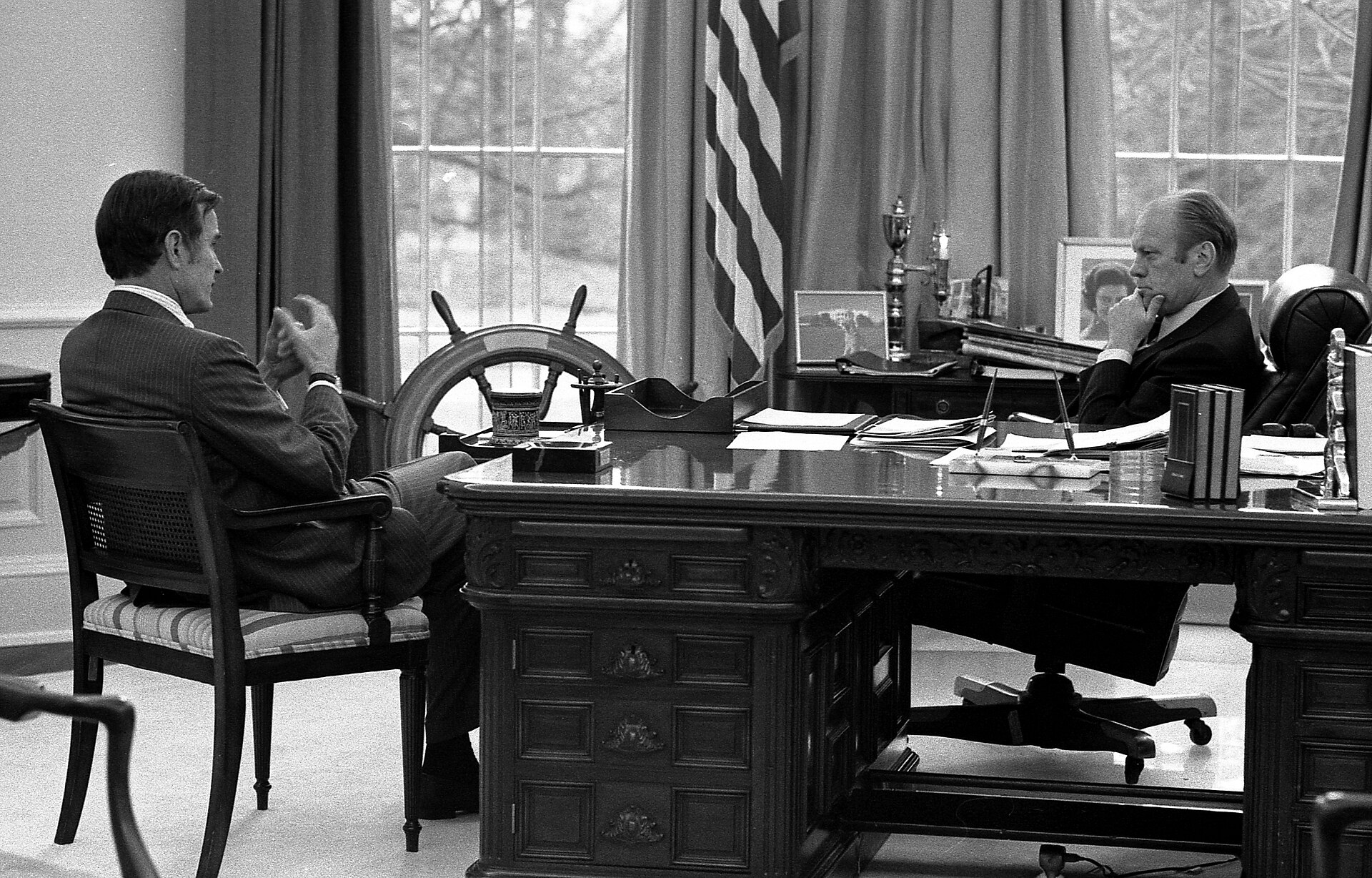 President Gerald Ford meeting with CIA Director–designate George H. W. Bush, December 17, 1975 Conditions worsened in the mid-1970s, around the time of Watergate. A dominant feature of political life during that period were the attempts of Congress to assert oversight of the U.S. presidency and the executive branch of the U.S. government. Revelations about past CIA activities, such as assassinations and attempted assassinations of foreign leaders (most notably Fidel Castro and Rafael Trujillo) and illegal domestic spying on U.S. citizens, provided the opportunities to increase Congressional oversight of U.S. intelligence operations.[152] In 1971, the NSA and CIA were engaged in domestic spying; the DOD was eavesdropping on Henry Kissinger. The White House and Camp David were wired for sound. Nixon and Kissinger were eavesdropping on their aides, as well as reporters. Famously, Nixon's Plumbers had in their number many former CIA officers, including Howard Hunt, Jim McCord, and Eugenio Martinez. On July 7, 1971, John Ehrlichman, Nixon's domestic policy chief, told DCI Cushman, Nixon's hatchet-man in the CIA, to let Cushman "know that [Hunt] was, in fact, doing some things for the President... you should consider he has pretty much carte blanche".[153] Hastening the CIA's fall from grace was the burglary of the Watergate headquarters of the Democratic Party by former CIA officers, and President Richard Nixon's subsequent attempt to use the CIA to impede the FBI's investigation of the burglary. In the famous "smoking gun" recording that led to President Nixon's resignation, Nixon ordered his chief of staff, H. R. Haldeman, to tell the CIA that further investigation of Watergate would "open the whole can of worms about the Bay of Pigs".[154][155] In this way Nixon and Haldeman ensured that the CIA's No. 1 and No. 2 ranking officials, Richard Helms and Vernon Walters, communicated to FBI Director L. Patrick Gray that the FBI should not follow the money trail from the burglars to the Committee to Re-elect the President, as it would uncover CIA informants in Mexico. The FBI initially agreed to this due to a long-standing agreement between the FBI and CIA not to uncover each other's sources of information, though within a couple of weeks the FBI resumed its investigation. Nonetheless, when the smoking gun tapes were made public, damage to the public's perception of CIA's top officials, and thus to the CIA as a whole, could not be avoided.[156] On November 13, 1972, after Nixon's landslide re-election, Nixon told Kissinger "[I intend] to ruin the Foreign Service. I mean ruin it – the old Foreign Service – and to build a new one." He had similar designs for the CIA and intended to replace Helms with James Schlesinger.[157] Nixon had promised that Helms could stay on until his 60th birthday, the mandatory retirement age. On February 2, Nixon broke that promise, carrying through with his intention to "remove the deadwood" from the CIA. "Get rid of the clowns" was his order to the incoming CI. Kissinger had been running the CIA since the beginning of Nixon's presidency, but Nixon impressed on Schlesinger that he must appear to Congress to be in charge, averting their suspicion of Kissinger's involvement.[158] Nixon also hoped that Schlesinger could push through broader changes in the intelligence community that he had been working towards for years, the creation of a Director of National Intelligence, and spinning off the covert action part of the CIA into a separate organ. Before Helms would leave office, he would destroy every tape he had secretly made of meetings in his office, and many of the papers on Project MKUltra. In Schlesinger's 17-week tenure, in his assertion to President Nixon that it was "imperative to cut back on 'the prominence of CIA operations' around the world," the director fired more than 1,500 employees.[159] As Watergate threw the spotlight on the CIA, Schlesinger, who had been kept in the dark about the CIA's involvement, decided he needed to know what skeletons were in the closet This became the Family Jewels. It included information linking the CIA to the assassination of foreign leaders, the illegal surveillance of some 7,000 U.S. citizens involved in the antiwar movement (Operation CHAOS), its experiments on U.S. and Canadian citizens without their knowledge, secretly giving them LSD (among other things) and observing the results.[152] This prompted Congress to create the Church Committee in the Senate, and the Pike Committee in the House. President Gerald Ford created the Rockefeller Commission,[152] and issued an executive order prohibiting the assassination of foreign leaders. DCI Colby leaked the papers to the press, later he stated that he believed that providing Congress with this information was the correct thing to do, and ultimately in the CIA's interests.[160] In December 1974 the New York Times reported that the CIA had collected intelligence files on at least 10,000 Americans and engaged in dozens of other illegal activities beginning in the 1950s, including break-ins, wiretapping and mail inspections, in violation of its 1947 charter which prohibited it from taking action on American soil and against US citizens.[161] |
CIA の権限の乱用、1970年代 関連項目:中央情報局の歴史 § ニクソン 1972年6月23日、ニクソン大統領とH.R.ハルデマンによる「スモーキングガン」会話(全文記録pdf)  ジェラルド・フォード大統領とCIA長官指名者ジョージ・H・W・ブッシュの会談、1975年12月17日 1970年代半ば、ウォーターゲート事件の頃、状況は悪化しました。この期間の政治の主な特徴は、議会が米国大統領および米国政府行政機関に対する監督権 限の強化を図ったことです。CIAの過去の活動に関する暴露、例えば外国首脳(特にフィデル・カストロとラファエル・トゥリヨ)の暗殺や暗殺未遂、米国市 民に対する違法な国内監視などが、議会による米国諜報活動への監督強化の機会を提供した。[152] 1971年、NSAとCIAは国内スパイ活動に従事していた。国防総省はヘンリー・キッシンジャーの盗聴を行っていた。ホワイトハウスとキャンプ・デー ビッドは盗聴装置が仕掛けられていた。ニクソンとキッシンジャーは、側近や記者たちの盗聴を行っていた。有名なように、ニクソンの「プラマーズ」には、ハ ワード・ハント、ジム・マコルド、エウジェニオ・マルティネスを含む多くの元CIA職員がいた。1971年7月7日、ニクソン大統領の国内政策担当首席補 佐官ジョン・エルリッヒマンは、CIA内のニクソン大統領の側近であるDCIカシュマンに対し、「ハントが実際、大統領のためにいくつかのことを行ってい ることを知っておくべきだ…彼はほぼ完全な自由裁量権を持っていると考えていい」と伝えた。[153] CIAの失墜を加速させたのは、元CIA職員による民主党本部ウォーターゲートビルの盗聴事件と、ニクソン大統領がCIAを利用してFBIの盗聴事件調査 を妨害しようとしたことだった。ニクソン大統領の辞任を招いた有名な「スモーキング・ガン」録音では、ニクソンは首席補佐官のH.R.ハルデマンに、 ウォーターゲート事件のさらなる調査は「ピッグス湾事件の全容を暴露する」とCIAに伝えるよう命じた。[154][155] このようにしてニクソンとハルデマンは、CIAのナンバー1とナンバー2の幹部であるリチャード・ヘルムズとバーノン・ウォルターズが、FBI長官のL・ パトリック・グレイに対し、FBIが窃盗犯から大統領再選委員会への資金の流れを追跡しないよう伝達させた。これは、メキシコにいるCIAの密告者を暴露 する恐れがあったためだ。FBIは当初、FBIとCIAの間で互いの情報源を暴露しないという長年の合意に基づき、この要請に応じたが、数週間後には調査 を再開した。しかし、決定的な証拠テープが公表されると、CIAの最高幹部に対する一般市民の信頼が損なわれ、その結果、CIA全体への打撃は避けられな かった。[156] 1972年11月13日、ニクソンが圧勝で再選された後、ニクソンはキッシンジャーに「私は外務省を破壊するつもりだ。古い外務省を破壊し、新しいものを 築くつもりだ」と述べた。彼は CIA についても同様の計画を立てており、ヘルムズをジェームズ・シュレシンジャーに交代させるつもりだった[157]。ニクソンは、ヘルムズが定年である 60 歳まで留まることを約束していた。しかし、2 月 2 日、ニクソンはその約束を破り、CIA から「死体」を排除するという意図を実行に移した。新 CIA 長官に対する彼の指示は「道化師たちを排除せよ」だった。ニクソン大統領就任以来、キッシンジャーが CIA を運営してきたが、ニクソンはシュレジンガーに対し、議会では自分が責任者であるように見せかけ、キッシンジャーの関与に対する議会の疑惑を回避するよう 強調した[158]。ニクソンはまた、シュレジンガーが、長年にわたって取り組んできた諜報機関の大規模な改革、国家情報長官の創設、CIA の秘密工作部門を独立した機関に分割することを推進することを期待していた。ヘルムズは退任前に、自身のオフィスで秘密裏に録音した会議のテープをすべて 破壊し、プロジェクトMKウルトラに関する多くの文書も破棄した。シュレスingerの17週間の在任期間中、ニクソン大統領に対し「CIAの活動の世界 的な存在感を縮小することが不可欠だ」と主張した同長官は、1,500人を超える職員を解雇した。[159] ウォーターゲート事件がCIAにスポットライトを当てた際、CIAの関与について知らされていなかったシュレスingerは、組織内に隠された秘密を把握 する必要があると判断した。 これが「ファミリー・ジュエルズ」となった。これには、CIAが外国首脳の暗殺に関与した証拠、反戦運動に関与した約7,000人の米国市民に対する違法 な監視(オペレーション・カオス)、米国とカナダの市民の同意なしに彼らにLSDを投与し、その結果を観察する実験(その他多数)に関する情報が含まれて いた。[152] これを受けて、議会は上院にチャーチ委員会、下院にパイク委員会を設置した。ジェラルド・フォード大統領はロックフェラー委員会を設立し、外国首脳の暗殺 を禁止する大統領令を発令した。CIA長官のコビーは文書をメディアに漏洩し、後に「議会にこの情報を提供することは正しい判断であり、最終的にCIAの 利益にかなう」と述べた。[160] 1974年12月、ニューヨーク・タイムズは、CIAが1950年代から少なくとも1万人のアメリカ人に関する諜報ファイルを収集し、1947年の憲章で 禁止されていたアメリカ国内での活動やアメリカ市民に対する行動を含む、数十件の違法活動(侵入、盗聴、郵便検査など)に従事していたと報じた。 [161] |
| Congressional investigations Acting Attorney General Laurence Silberman learned of the existence of the Family Jewels and issued a subpoena for them, prompting eight congressional investigations on the domestic spying activities of the CIA. Bill Colby's short tenure as DCI would end with the Halloween Massacre. His replacement was George H. W. Bush. At the time, the DOD had control of 80% of the intelligence budget.[162] Communication and coordination between the CIA and the DOD would suffer greatly under Defense Secretary Donald Rumsfeld. The CIA's budget for hiring clandestine officers had been squeezed out by the paramilitary operations in Southeast Asia, and the government's poor popularity further strained hiring. This left the agency bloated with middle management, and anemic in younger officers. With employee training taking five years, the agency's only hope would be on the trickle of new officers coming to fruition years in the future. The CIA would see another setback as communists would take Angola. William J. Casey, a member of Ford's Intelligence Advisory Board, obtained Bush's approval to allow a team from outside the CIA to produce Soviet military estimates as a "Team B". The "B" team was composed of hawks. Their estimates were the highest that could be justified, and they painted a picture of a growing Soviet military when the Soviet military was indeed shrinking. Many of their reports found their way to the press. |
議会調査 ローレンス・シルバーマン司法長官代理は「ファミリー・ジュエルズ」の存在を知り、その提出を命じる召喚状を発行した。これにより、CIA の国内スパイ活動に関する 8 件の議会調査が開始された。ビル・コルビーの DCI としての短い任期は、ハロウィーン・マサカーで終了した。後任にはジョージ・H・W・ブッシュが就任した。当時、国防総省は諜報予算の 80% を支配していた[162]。CIA と国防総省間のコミュニケーションと調整は、ドナルド・ラムズフェルド国防長官の下で大きな苦悩に直面することになった。CIA の秘密工作員採用予算は、東南アジアでの準軍事作戦によって圧迫されており、政府の人気低下も採用をさらに困難にしていた。その結果、CIA は中間管理職が肥大化し、若手工作員は不足していた。職員の訓練に5年を要する中、機関の唯一の希望は、数年後にようやく成果を上げる新任職員のわずかな 流入に懸かっていた。CIAは、アンゴラで共産主義者が権力を掌握したことで、さらなる打撃を受けることになった。フォードの諜報顧問会議のメンバーであ るウィリアム・J・ケイシーは、ブッシュの承認を得て、CIA外部のチームに「チームB」としてソ連の軍事評価を策定させることを許可した。「Bチーム」 はタカ派で構成され、彼らの評価は正当化できる最高水準であり、ソ連軍が縮小傾向にあったにもかかわらず、拡大しているという状況を描いた。彼らの報告書 の多くはメディアに流出した。 |
| Chad Main article: CIA activities in Chad Chad's neighbor Libya was a major source of weaponry to communist rebel forces. The CIA seized the opportunity to arm and finance Chad's Prime Minister, Hissène Habré, after he created a breakaway government in western Sudan.[163] |
チャド 主な記事:チャドにおけるCIAの活動 チャドの隣国リビアは、共産主義の反政府勢力への武器の主要供給源だった。CIAは、ヒッセン・ハブレがスーダン西部に分離独立政府を設立したことを受け、彼を武装し、資金援助するチャンスをつかんだ。[163] |
| Afghanistan See also: CIA activities in Afghanistan and Operation Cyclone Further information: Allegations of CIA assistance to Osama bin Laden  Critics assert that funding the Afghan mujahideen in Operation Cyclone played a role in causing the September 11 attacks. In Afghanistan, the CIA funneled several billion dollars' worth of weapons,[164] including FIM-92 Stinger surface-to-air missiles,[165] to Pakistani Inter-Services Intelligence (ISI)—which funneled them to tens of thousands of Afghan mujahideen resistance fighters in order to fight the Soviets and the Armed Forces of the Democratic Republic of Afghanistan during the Soviet-Afghan War.[166][167][168] In total, the CIA sent approximately 2,300 Stingers to Afghanistan, creating a substantial black market for the weapons throughout the Middle East, Central Asia, and even parts of Africa that persisted well into the 1990s. Perhaps 100 Stingers were acquired by Iran. The CIA later operated a program to recover the Stingers through cash buybacks.[169] |
アフガニスタン 関連項目:CIAのアフガニスタン活動およびオペレーション・サイクロン 詳細情報:CIAのオサマ・ビンラーディン支援疑惑  批評家は、オペレーション・サイクロンにおけるアフガニスタンのムジャヒディンへの資金援助が、9月11日の同時多発テロの原因となったと主張している。 アフガニスタンでは、CIAは数億ドル相当の武器[164](FIM-92スティンガー地対空ミサイルを含む[165])をパキスタンの軍情報機関 (ISI)に提供し、ISIはそれらをソ連とアフガニスタン民主共和国軍と戦うアフガニスタンのムジャヒディン抵抗勢力に数万人に渡した。[166] [167][168] 総計でCIAはアフガニスタンに約2,300発のスティンガーを送り、中東、中央アジア、さらにはアフリカの一部で1990年代後半まで持続した大規模な 武器の闇市場を生み出した。イランが約100発のスティンガーを入手した可能性がある。CIAは後に、現金買い戻しを通じてスティンガーを回収するプログ ラムを実施した。[169] |
| Nicaragua See also: History of the Central Intelligence Agency § Iran/Contra Further information: Contras and Reagan Doctrine Under President Jimmy Carter, the CIA was conducting covertly funded support for the Contras in their war against the Sandinistas. In March 1981, Reagan told Congress that the CIA would protect El Salvador by preventing the Sandinistas from shipping arms to communist rebels in El Salvador. The CIA also began arming and training the Contras in Honduras in hopes that they could depose the Sandinistas in Nicaragua.[170] The CIA was involved in the Iran–Contra affair arms smuggling scandal. Repercussions from the scandal included the creation of the Intelligence Authorization Act in 1991. It defined covert operations as secret missions in geopolitical areas where the U.S. is neither openly nor apparently engaged. This also required an authorizing chain of command, including an official, presidential finding report and the informing of the House and Senate Intelligence Committees, which, in emergencies, requires only "timely notification." Critics have alleged that the CIA was also involved in Contra cocaine trafficking.[171][172] |
ニカラグア 参照:中央情報局の歴史 § イラン・コントラ事件 詳細情報:コントラとレーガン・ドクトリン ジミー・カーター大統領の下、CIA は、サンディニスタとの戦争でコントラに秘密の資金援助を行っていた。1981年3月、レーガンは議会で、CIA はサンディニスタがエルサルバドルの共産主義反政府勢力に武器を輸送することを阻止し、エルサルバドルを保護すると述べた。CIAはまた、ホンジュラスで コントラへの武器供与と訓練を開始し、ニカラグアのサンディニスタ政権を打倒することを目指した。[170] CIAはイラン・コントラ事件の武器密輸スキャンダルにも関与していた。このスキャンダルの余波として、1991年に「情報活動承認法」が制定された。同 法は、秘密作戦を「米国が公然とまたは明らかに関与していない地政学的地域における秘密任務」と定義した。これには、大統領の公式報告書を含む承認の指揮 系統の確立が求められ、下院と上院の諜報委員会への報告が義務付けられた。緊急時には「適切な通知」のみで済む。批判者は、CIAがコントラ勢力のコカイ ン密輸にも関与していたと主張している。[171][172] |
| Lebanon The CIA's prime source in Lebanon was Bashir Gemayel, a member of the Christian Maronite sect. The uprising against the Maronite minority blindsided the CIA. Israel invaded Lebanon, and, along with the CIA, propped up Gemayel. This secured Gemayel's assurance that Americans would be protected in Lebanon. Thirteen days later he was assassinated. Imad Mughniyah, a Hezbollah assassin, targeted Americans in retaliation for the Israeli invasion, the Sabra and Shatila massacre, and the US Marines of the Multi-National Force for their role in opposing the PLO in Lebanon. On April 18, 1983, a 2,000 lb car bomb exploded in the lobby of the American embassy in Beirut, killing 63 people, including 17 Americans and 7 CIA officers, including Robert Ames, one of the CIA's Middle East experts. America's fortunes in Lebanon suffered more as America's poorly directed retaliation for the bombing was interpreted by many as support for the Maronite minority. On October 23, 1983, two bombs (1983 Beirut Bombing) were set off in Beirut, including a 10-ton bomb at a US military barracks that killed 242 people. The embassy bombing killed Ken Haas, the CIA's Station Chief in Beirut. Bill Buckley was sent in to replace him. Eighteen days after the US Marines left Lebanon, Buckley was kidnapped. On March 7, 1984, Jeremy Levin, CNN's Bureau Chief in Beirut, was kidnapped. Twelve more Americans were captured in Beirut during the Reagan Administration. Manucher Ghorbanifar, a former Savak agent, was an information seller, and was discredited over his record of misinformation. He reached out to the agency offering a back channel to Iran, suggesting a trade of missiles that would be lucrative to the intermediaries.[173] |
レバノン CIA のレバノンにおける主要情報源は、キリスト教マロン派の一員であるバシール・ジェマイエルだった。マロン派少数派に対する反乱は、CIA を不意打ちした。イスラエルはレバノンに侵攻し、CIA と共にジェマイエルを支援した。これにより、ジェマイエルは、レバノンにおけるアメリカ人の安全が保証されることになった。13日後、彼は暗殺された。ヒ ズボラの暗殺者、イマード・ムグニヤは、イスラエルの侵攻、サブラとシャティラの虐殺、そしてレバノンにおける PLO 反対運動に関与した多国籍軍(US Marines)の米海兵隊員たちを報復の対象とした。1983年4月18日、2,000ポンドの自動車爆弾がベイルートのアメリカ大使館ロビーで爆発 し、17人のアメリカ人と、CIAの中東専門家であるロバート・エイムズを含む7人のCIA職員を含む63人が死亡した。この爆弾事件に対するアメリカの 報復は不適切であり、多くの人々からマロン派少数派への支援と解釈されたため、レバノンにおけるアメリカの運命はさらに苦悩に満ちたものとなった。 1983年10月23日、ベイルートで2つの爆弾(1983年ベイルート爆弾事件)が爆発し、そのうちの1つは米軍の兵舎で爆発し、242人が死亡した。 この大使館爆破事件で、CIA のベイルート支局長ケン・ハースが死亡した。彼の後任としてビル・バックリーが派遣された。米海兵隊がレバノンから撤退してから 18 日後、バックリーは誘拐された。1984年3月7日、CNN のベイルート支局長ジェレミー・レビンが誘拐された。レーガン政権時代、さらに 12 人のアメリカ人がベイルートで捕らえられた。元サヴァク(イランの秘密警察)のエージェントで情報提供者だったマヌチェール・ゴルバニファールは、誤報の 記録で信用を失っていた。彼は機関に接触し、仲介者に利益をもたらすミサイルの取引を提案する裏ルートを提供した。[173] |
| Pakistan Main article: CIA activities in Pakistan It has been alleged by such authors as Ahmed Rashid that the CIA and ISI have been waging a clandestine war. |
パキスタン 主な記事:パキスタンにおけるCIAの活動 アフマド・ラシッドなどの著者は、CIAとISIが秘密戦争を繰り広げていると主張している。 |
| India–Pakistan geopolitical tensions On May 11, 1998, CIA Director George Tenet and his agency were taken aback by India's second nuclear test. The test prompted concerns from its nuclear-capable adversary, Pakistan, and, "remade the balance of power in the world." The nuclear test was New Delhi's calculated response to Pakistan previously testing new missiles in its expanding arsenal. This series of events subsequently revealed the CIA's "failure of espionage, a failure to read photographs, a failure to comprehend reports, a failure to think, and a failure to see."[174] |
インドとパキスタンの地政学的緊張 1998年5月11日、CIA長官ジョージ・テネットとその機関は、インドの2回目の核実験に驚愕した。この実験は、核保有国であるパキスタンに懸念を引 き起こし、「世界の勢力均衡を一変させた」。この核実験は、パキスタンが拡大する兵器庫で新型ミサイルの試験発射を行ったことに対するニューデリーの計算 された対応だった。この一連の出来事は、CIAの「諜報活動の失敗、写真分析の失敗、報告書の理解不足、思考の欠如、そして状況認識の欠如」を浮き彫りに した。[174] |
| Poland, 1980–1989 See also: Poland–United States relations Unlike the Carter administration, the Reagan administration supported the Solidarity movement in Poland, and – based on CIA intelligence – waged a public relations campaign to deter what the Carter administration felt was "an imminent move by large Soviet military forces into Poland." Colonel Ryszard Kukliński, a senior officer on the Polish General Staff, was secretly sending reports to the CIA.[175] The CIA transferred around $2 million yearly in cash to Solidarity, which suggests that $10 million total is a reasonable estimate for the five-year total. There were no direct links between the CIA and Solidarność, and all money was channeled through third parties.[176] CIA officers were barred from meeting Solidarity leaders, and the CIA's contacts with Solidarność activists were weaker than those of the AFL–CIO, which raised 300 thousand dollars from its members, which were used to provide material and cash directly to Solidarity, with no control of Solidarity's use of it. The U.S. Congress authorized the National Endowment for Democracy to promote democracy, and the NED allocated $10 million to Solidarity.[177] When the Polish government launched a crackdown in December 1981, Solidarity was not alerted. Explanations for this vary; some believe the CIA was caught off guard, while others suggest that American policymakers viewed an internal crackdown as preferable to an "inevitable Soviet intervention."[178] CIA support for Solidarity included money, equipment and training, which was coordinated by Special Operations CIA division.[179] Henry Hyde, U.S. House intelligence committee member, said that the U.S. provided "supplies and technical assistance in terms of clandestine newspapers, broadcasting, propaganda, money, organizational help and advice".[180] Michael Reisman of Yale Law School named operations in Poland as one of the CIA's Cold War covert operations.[181] Initial funds for covert actions by the CIA were $2 million, but authorization was soon increased and by 1985 the CIA had successfully infiltrated Poland.[182] Rainer Thiel, in Nested Games of External Democracy Promotion: The United States and the Polish Liberalization 1980–1989, mentions how covert operations by the CIA, and spy games, among others, allowed the U.S. to proceed with successful regime change.[183] |
ポーランド、1980年~1989年 参照:ポーランドとアメリカ合衆国の関係 カーター政権とは異なり、レーガン政権はポーランドの連帯運動を支援し、CIAの情報に基づいて、カーター政権が「ソ連軍の大規模なポーランド侵攻が差し 迫っている」と認識していたことを阻止するための広報キャンペーンを展開した。ポーランド参謀本部の高官であるリシャール・ククリンスキ大佐は、CIAに 秘密裏に報告を送っていた。[175] CIAは、連帯に年間約200万ドルの現金を送金しており、5年間の総額は1,000万ドルと推定するのが妥当だ。CIAとソリダリティの間には直接のつ ながりはなく、すべての資金は第三者を通じて送金されていた。[176] CIAの職員はソリダリティの指導者と会うことが禁止されており、CIAのソリダリティ活動家との接触は、会員から30万ドルを調達し、その資金をソリダ リティに直接物資や現金として提供したAFL–CIOよりも弱かった。ソリダリティの資金使用はAFL–CIOの管理下にはなかった。米国議会は、民主主 義の促進を目的とした国家民主化基金(NED)の設立を承認し、NED は連帯に 1,000 万ドルを拠出した[177]。 1981年12月にポーランド政府が弾圧を開始したとき、連帯は警告を受けていなかった。この理由については、CIAが不意を突かれたとの見方がある一方、米国の政策立案者は、ソ連の介入は「避けられない」と見て、内部弾圧を望んだとの見方もある。[178] CIAのソリダリティ支援には、資金、装備、訓練が含まれ、CIAの特殊作戦部門が調整を担当した。[179] 下院情報委員会委員は、アメリカが「秘密新聞、放送、宣伝、資金、組織的支援、助言」に関する「物資と技術的支援」を提供したと述べた。[180] イエール大学法学部のマイケル・ライズマンは、ポーランドでの作戦をCIAの冷戦時代の秘密作戦の一つに挙げた。[181] CIAの秘密行動の初期資金は$200万ドルだったが、承認はすぐに増額され、1985年までにCIAはポーランドへの浸透に成功した。[182] ライナー・ティールは『外部民主主義促進の入れ子ゲーム: The United States and the Polish Liberalization 1980–1989』では、CIAの秘密作戦やスパイ活動などが、米国が政権交代を成功させるための要因となったと述べている。[183] |
| Operation Gladio Main article: Operation Gladio During the Cold War, the CIA and NATO were involved in Operation Gladio.[184][185] As part of Operation Gladio, the CIA supported the Italian government, and allegedly supported neo-fascist organizations[186][187][188] such as National Vanguard, New Order and the Nuclei Armati Rivoluzionari during the Years of Lead in Italy. In Turkey, Gladio was called Counter-Guerrilla. CIA efforts strengthened the Pan-Turkist movement through the founding member of the Counter-Guerrilla; Alparslan Türkeş.[189] Other far-right individuals employed by the CIA as part of Counter-Guerilla included Ruzi Nazar, a former SS officer and Pan-Turkist.[190] |
オペレーション・グラディオ 主な記事:グラディオ作戦 冷戦時代、CIA と NATO はグラディオ作戦に関与していた[184][185]。グラディオ作戦の一環として、CIA はイタリア政府を支援し、イタリアの鉛の年代(1960年代から1980年代)に、ナショナル・ヴァンガード、ニュー・オーダー、ヌクレイ・アルマティ・ リヴォルツィオナリなどの新ファシスト組織を支援したとされている[186][187][188]。 トルコでは、グラディオは「カウンター・ゲリラ」と呼ばれていた。CIAの努力は、カウンター・ゲリラの創設メンバーであるアルパルスラン・トゥルケシュ を通じて、パン・トルキスト運動を強化した。[189] カウンター・ゲリラの一員としてCIAに雇用された他の極右人物には、元SS将校でパン・トルキストのルジ・ナザールが含まれていた。[190] |
| Operation Desert Storm Main article: Gulf War During the Iran–Iraq War, the CIA had backed both sides. The CIA had maintained a network of spies in Iran, but in 1989 a CIA mistake compromised every agent they had in there, and the CIA had no agents in Iraq. In the weeks before the Iraqi invasion of Kuwait, the CIA downplayed the military buildup. During the war, CIA estimates of Iraqi abilities and intentions flip-flopped and were rarely accurate. In one particular case, the DOD had asked the CIA to identify military targets to bomb. One target the CIA identified was an underground shelter. The CIA did not know that it was a civilian bomb shelter. In a rare instance, the CIA correctly determined that the coalition forces efforts were coming up short in their efforts to destroy SCUD missiles. Congress took away the CIA's role in interpreting spy-satellite photos, putting the CIA's satellite intelligence operations under the auspices of the military. The CIA created its office of military affairs, which operated as "second-echelon support for the Pentagon. .. answering ... questions from military men [like] 'how wide is this road?'"[191] |
砂漠の嵐作戦 主な記事:湾岸戦争 イラン・イラク戦争中、CIA は双方を支援していた。CIA はイランにスパイのネットワークを維持していたが、1989 年に CIA のミスにより、イラン国内のすべての工作員が身元を暴露され、CIA はイラクに工作員を 1 人も残さなかった。イラクがクウェート侵攻を行う数週間前、CIA は軍事力の増強を軽視していた。戦争中、CIA のイラク軍の能力と意図に関する予測は翻弄され、正確だったことはほとんどなかった。あるケースでは、国防総省が CIA に爆撃目標の特定を依頼した。CIA が特定した目標のひとつは地下シェルターだった。CIA は、それが民間の防空壕であることを知らなかった。まれなケースだが、CIA は、連合軍が SCUD ミサイルの破壊作戦で成果を上げていないことを正しく判断した。議会はCIAの諜報衛星写真の解釈役割を剥奪し、CIAの衛星諜報活動を軍の管轄下に置い た。CIAは軍事事務局を設置し、これは「国防総省の第二線支援」として機能し、「この道路の幅はどれくらいか」といった軍事関係者からの質問に答える役 割を果たした。[191] |
| Fall of the Soviet Union See also: History of the Central Intelligence Agency § Fall of the USSR Mikhail Gorbachev's announcement of the unilateral reduction of 500,000 Soviet troops took the CIA by surprise. Moreover, Doug MacEachin, the CIA's Chief of Soviet analysis, said that even if the CIA had told the President, the NSC, and Congress about the cuts beforehand, it would have been ignored. "We never would have been able to publish it."[192] All the CIA numbers on the Soviet Union's economy were wrong. Too often the CIA relied on inexperienced people supposedly deemed experts. Bob Gates had preceded Doug MacEachin as Chief of Soviet analysis, and he had never visited the Soviet Union. Few officers, even those stationed in the country, spoke the language of the people on whom they spied. And the CIA could not send agents to respond to developing situations. The CIA analysis of Russia during the Cold War was either driven by ideology, or by politics. William J. Crowe, the Chairman of the Joint Chiefs of Staff, noted that the CIA "talked about the Soviet Union as if they weren't reading the newspapers, much less developed clandestine intelligence."[193] On January 25, 1993, Mir Qazi opened fire at the CIA headquarters in Langley, Virginia, killing two officers and wounding three others.[194] On February 26, Al-Qaeda terrorists led by Ramzi Yousef bombed the parking garage below the North Tower of the World Trade Center in New York City, killing six people and injuring 1,402 others. During the Bosnian War, the CIA ignored signs within and without[clarification needed] of the Srebrenica massacre. On July 13, 1995, when the press report about the massacre came out, the CIA received pictures from a spy satellite of prisoners guarded by men with guns in Srebrenica.[195] The CIA had no agents on the ground to verify the report. Two weeks after news reports of the slaughter, the CIA sent a U-2 to photograph it. A week later the CIA completed its report on the matter. The final report came to the Oval Office on August 4, 1995. In short, it took three weeks for the agency to confirm that one of the largest mass murders in Europe since the Second World War had occurred.[195] Another CIA mistake which occurred in the Balkans during the Clinton presidency was the NATO bombing of Serbia. To force Slobodan Milošević to withdraw his troops from Kosovo, the CIA had been invited to provide military targets for bombings, wherein the agency's analysts used tourist maps to determine the location.[196] However, the agency incorrectly provided the coordinates of the Chinese Embassy as a target resulting in its bombing. The CIA had misread the target as Slobodan Milosevic's military depot.[197] In Guatemala, the CIA produced the Murphy Memo, based on audio recordings made by covert listening devices planted by Guatemalan intelligence in the bedroom of Ambassador Marilyn McAfee. In the recording, Ambassador McAfee verbally entreated "Murphy." The CIA circulated a memo in the highest Washington circles accusing Ambassador McAfee of having an extramarital lesbian affair with her secretary, Carol Murphy. There was no affair. Ambassador McAfee was calling to Murphy, her poodle.[198] Harold James Nicholson would burn[clarification needed] several serving officers and three years of trainees before he was caught spying for Russia. In 1997 the House would pen another report, which said that CIA officers know little about the language or politics of the people they spy on; the conclusion was that the CIA lacked the "depth, breadth, and expertise to monitor political, military, and economic developments worldwide."[199] Russ Travers said in the CIA in-house journal that in five years "intelligence failure is inevitable".[200] In 1997 the CIA's new director George Tenet would promise a new working agency by 2002. The CIA's surprise at India's detonation of an atom bomb was a failure at almost every level. After the 1998 embassy bombings by Al Qaeda, the CIA offered two targets to be hit in retaliation. One of them was the Al-Shifa pharmaceutical factory, where traces of chemical weapon precursors had been detected. In the aftermath, it was concluded that "the decision to target al Shifa continues a tradition of operating on inadequate intelligence about Sudan." It triggered the CIA to make "substantial and sweeping changes" to prevent "a catastrophic systemic intelligence failure."[201] |
ソビエト連邦の崩壊 関連項目:中央情報局の歴史 § ソビエト連邦の崩壊 ミハイル・ゴルバチョフがソ連軍50万人の一方的な削減を発表したとき、CIAは驚きを隠せなかった。さらに、CIAのソ連分析部長だったダグ・マッケイ チンは、CIAが事前に大統領、国家安全保障会議(NSC)、議会に削減について報告していたとしても、それは無視されていただろうと述べている。「それ を公表することは決してできなかっただろう」[192]。CIA のソ連経済に関する数字は、すべて間違っていた。CIA は、経験の浅い、専門家とみなされる人物に過度に依存していた。ダグ・マッケアチンの前任のソ連分析部長だったボブ・ゲイツは、ソ連を訪れたことがなかっ た。ソ連に駐在していた職員でさえ、スパイ対象である人民の言語を話す者はほとんどいなかった。CIAは、状況の変化に対応するためにエージェントを派遣 することもできなかった。冷戦中のCIAのロシア分析は、イデオロギーか政治に駆り立てられていた。統合参謀本部議長ウィリアム・J・クロウは、CIAは 「ソ連について、新聞すら読んでいないかのように話していた。ましてや秘密諜報活動を行っていたわけではなかった」と指摘した。[193] 1993年1月25日、ミル・カジーはバージニア州ラングレーにあるCIA本部に発砲し、2人の職員を殺害、3人を負傷させた[194]。2月26日、ラ ムジ・ユセフ率いるアルカイダのテロリストたちが、ニューヨーク市の世界貿易センター北棟の地下駐車場を爆破し、6人が死亡、1,402人が負傷した。 ボスニア戦争中、CIA はスレブレニツァの虐殺に関する内部および外部の兆候を無視した。1995年7月13日、虐殺に関する報道が流れたとき、CIA は、スレブレニツァで銃を持った男たちに守られている囚人の写真をスパイ衛星から受け取った。[195] CIA には、その報道を検証するための現地工作員はいない。虐殺に関する報道から 2 週間後、CIA は U-2 を派遣してその様子を撮影しました。1週間後、CIA はこの件に関する報告書を完成させた。最終報告書は 1995 年 8 月 4 日に大統領執務室(オーバルオフィス)に提出された。要するに、第二次世界大戦以来、ヨーロッパで最大の大量殺戮事件が発生したことを CIA が確認するのに 3 週間もかかったのだ[195]。クリントン大統領の在任中にバルカン半島で発生したもう 1 つの CIA の失態は、NATO によるセルビア爆撃だ。スロボダン・ミロシェビッチにコソボからの軍隊撤退を迫るため、CIA は爆撃の軍事目標の提供を依頼され、その分析官たちは観光用地図を使って目標の位置を決定した。[196] しかし、CIA は中国大使館の座標を誤って目標として提供し、その結果、大使館が爆撃された。CIA は、その目標をスロボダン・ミロシェビッチの軍事倉庫と誤読していたのだ。[197] グアテマラでは、CIA は、グアテマラ情報機関がマリリン・マカフィー大使の寝室に設置した盗聴装置による録音に基づいて、「マーフィー・メモ」を作成した。録音では、マカ フィー大使が「マーフィー」と口頭で懇願している。CIA は、マカフィー大使が秘書であるキャロル・マーフィーと不倫関係にあると非難するメモを、ワシントンの最高権力者たちに回覧した。しかし、不倫は存在しな かった。マカフィー大使は、自分のプードルであるマーフィーに電話していたのだ[198]。 ハロルド・ジェームズ・ニコルソンは、ロシアのスパイ活動が発覚する前に、複数の現役将校と 3 年間の研修生を「燃やす」[説明が必要] ことになった。1997 年、下院は別の報告書を作成し、CIA の職員はスパイ対象国の言語や政治についてほとんど知識がない、と述べた。その結論は、CIA には「世界中の政治、軍事、経済動向を監視するための深さ、幅、専門知識」が欠けている、というものであった。[199] ラス・トラバースは、CIA の社内誌で、5 年以内に「諜報の失敗は避けられない」と述べた。[200] 1997 年、CIA の新長官ジョージ・テネットは、2002 年までに新しい業務機関を設立することを約束した。インドによる原子爆弾の爆発に対する CIA の驚きは、ほぼあらゆるレベルでの失敗だった。1998年のアルカイダによる大使館爆破事件後、CIAは報復攻撃の対象として2つの標的を提示した。その 一つは、化学兵器の前駆物質の痕跡が検出されたアル・シファ製薬工場だった。事後、この決定は「スーダンに関する不十分な情報に基づいて行動する伝統を継 続するものだった」と結論付けられた。これにより、CIAは「壊滅的なシステム的な情報失敗」を防止するため、「大幅かつ包括的な変更」を実施することに なった。[201] |
| Aldrich Ames See also: Aldrich Ames Between 1985 and 1986, the CIA lost every spy it had in Eastern Europe. The details of the investigation into the cause were obscured from the new Director, and the investigation had little success and has been widely criticized. On February 21, 1994, FBI agents pulled Aldrich Ames out of his Jaguar.[202] In the investigation that ensued, the CIA discovered that many of the sources for its most important analyses of the USSR were based on Soviet disinformation fed to the CIA by controlled agents. On top of that, it was discovered that, in some cases, the CIA suspected at the time that the sources were compromised, but the information was sent up the chain as genuine.[203][204] |
アルドリッチ・エイムズ 参照:アルドリッチ・エイムズ 1985年から1986年にかけて、CIAは東ヨーロッパに派遣していたスパイを全員失った。その原因に関する調査の詳細は新長官には隠蔽され、調査はほ とんど成果を上げず、広く批判された。1994年2月21日、FBI捜査官はアルドリッチ・エイムズをジャガーから引きずり出した。[202] その後行われた調査で、CIAは、ソ連に関する最も重要な分析の多くの情報源が、CIAにコントロールされたエージェントから提供されたソ連の偽情報に基 づいていたことを発見した。さらに、一部のケースでは、CIAは当時情報源が漏洩している可能性を疑っていたにもかかわらず、その情報を本物として上層部 に報告していたことが判明した。[203][204] |
| Osama bin Laden Agency files show that it is believed Osama bin Laden was funding the Afghan rebels against the USSR in the 1980s.[205] In 1991, bin Laden returned to his native Saudi Arabia protesting the presence of troops, and Operation Desert Storm. He was expelled from the country. In 1996, the CIA created a team to hunt bin Laden. They were trading information with the Sudanese until, on the word of a source that would later be found to be a fabricator, the CIA closed its Sudan station later that year. In 1998, bin Laden would declare war on America, and, on August 7, strike in Tanzania and Nairobi. On October 12, 2000, Al Qaeda bombed the USS Cole. In the first days of George W. Bush's presidency, Al Qaeda threats were ubiquitous in daily presidential CIA briefings, but it may have become a case of false alarm. The agency's predictions were dire but carried little weight, and the focus of the president and his defense staff were elsewhere. The CIA arranged the arrests of suspected Al Qaeda members through cooperation with foreign agencies, but the CIA could not definitively say what effect these arrests have had, and it could not gain hard intelligence from those captured. The President had asked the CIA if Al Qaeda could plan attacks in the US. On August 6, Bush received a daily briefing with the headline, not based on current, solid intelligence, "Al Qaeda determined to strike inside the US." The US had been hunting bin Laden since 1996 and had had several opportunities, but neither Clinton, nor Bush had wanted to risk taking an active role in a murky assassination plot, and the perfect opportunity had never materialized for a DCI that would have given him the reassurances he needed to take the plunge. That day, Richard A. Clarke sent National Security Advisor Condoleezza Rice warning of the risks, and decrying the inaction of the CIA.[206] |
オサマ・ビンラーディン CIAのファイルによると、オサマ・ビンラーディンは1980年代に、ソ連に対するアフガニスタンの反政府勢力に資金を提供していたと考えられている [205]。1991年、ビンラーディンは、軍隊の駐留と「砂漠の嵐作戦」に抗議して、故郷のサウジアラビアに戻った。彼は国外追放された。1996年、 CIAはビンラーディンを追跡するためのチームを設立した。彼らはスーダン当局と情報を交換していたが、後に偽情報提供者であることが判明した情報源の報 告に基づき、CIAは同年中にスーダン支局を閉鎖した。1998年、ビン・ラディンはアメリカへの戦争を宣言し、8月7日にタンザニアとナイロビで攻撃を 実行した。2000年10月12日、アルカイダは米海軍艦艇コールを爆破した。ジョージ・W・ブッシュ大統領就任当初、アルカイダの脅威は、大統領の毎日 のCIA報告で頻繁に取り上げられていたが、それは誤報だったかもしれない。CIAの予測は悲惨なものだったが、その予測はほとんど重要視されず、大統領 と国防担当スタッフは他の問題に関心を向けていた。CIA は、外国機関と協力し、アルカイダの容疑者の逮捕を手配したが、これらの逮捕がどのような効果をもたらしたかは CIA には定かではなく、逮捕者からも確固たる情報は得られなかった。大統領は、アルカイダが米国で攻撃を計画しているかどうかを CIA に尋ねた。8 月 6 日、ブッシュ大統領は、現在の確固たる情報に基づくものではない「アルカイダは米国内で攻撃を行う決意を固めている」という見出しの毎日のブリーフィング を受けた。米国は 1996 年からビンラディンを追い続けており、何度かチャンスもあったが、クリントンもブッシュも、不透明な暗殺計画に積極的な役割を果たすリスクを冒したくな かった。DCI が決断を下すために必要な安心材料となる絶好のチャンスは、決して訪れなかった。その日、リチャード・A・クラークは、国家安全保障問題担当大統領補佐官 のコンドリーザ・ライスに、その危険性を警告し、CIA の無為無策を非難する書簡を送った[206]。 |
| Al-Qaeda and the Global War on Terrorism Further information: CIA transnational anti-terrorism activities, Human rights violations by the CIA, and Senate Intelligence Committee report on CIA torture 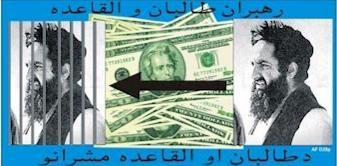 The CIA prepared a series of leaflets announcing bounties for those who turned in or denounced individuals suspected of association with the Taliban or Al-Qaeda. In January 1996, the CIA created an experimental "virtual station," the Bin Laden Issue Station, under the Counterterrorist Center, to track bin Laden's developing activities. Al-Fadl, who defected to the CIA in spring 1996, began to provide the Station with a new image of the Al Qaeda leader: he was not only a terrorist financier but a terrorist organizer as well. FBI Special Agent Dan Coleman (who together with his partner Jack Cloonan had been "seconded" to the bin Laden Station) called him Qaeda's "Rosetta Stone".[207] In 1999, CIA chief George Tenet launched a plan to deal with al-Qaeda. The Counterterrorist Center, its new chief, Cofer Black, and the center's bin Laden unit were the plan's developers and executors. Once it was prepared, Tenet assigned CIA intelligence chief Charles E. Allen to set up a "Qaeda cell" to oversee its tactical execution.[208] In 2000, the CIA and USAF jointly ran a series of flights over Afghanistan with a small remote-controlled reconnaissance drone, the Predator; they obtained probable photos of bin Laden. Cofer Black and others became advocates of arming the Predator with missiles to try to assassinate bin Laden and other al-Qaeda leaders. |
アルカイダと世界的なテロとの戦い 詳細情報:CIA の国境を越えたテロ対策活動、CIA による人権侵害、上院情報委員会による CIA の拷問に関する報告書  CIA は、タリバンやアルカイダと関係のある人物を通報または告発した者に報奨金を支払うことを告知する一連のチラシを作成した。 1996年1月、CIAは対テロセンターの下に実験的な「バーチャル・ステーション」であるビンラディン問題ステーションを設立し、ビンラディンの活動動 向を追跡した。1996年春にCIAに亡命したアル・ファドルは、ステーションにアルカイダの指導者の新たな像を提供し始めた。彼は単なるテロリストの資 金提供者ではなく、テロリストの組織者でもあった。FBI特別捜査官ダン・コールマン(パートナーのジャック・クロナンと共にビンラディン・ステーション に「出向」していた)は、彼をアルカイダの「ロゼッタストーン」と呼んだ。[207] 1999年、CIA長官ジョージ・テネットはアルカイダ対策計画を立案した。同計画の立案・実行を担当したのは、対テロセンター、同センターの新長官コ ファー・ブラック、および同センターのビンラディン部門だった。計画が策定されると、テネットはCIAの諜報部長チャールズ・E・アレンに、その戦術的実 行を監督する「アルカイダ細胞」の設立を命じた。[208] 2000年、CIAと米空軍はアフガニスタン上空で小型の遠隔操作偵察ドローン「プレデター」を用いた一連の飛行を実施し、ビン・ラディンの可能性のある 写真を撮影した。コファー・ブラックを含む関係者は、プレデターにミサイルを装備し、ビンラディンを含むアルカイダ指導部の暗殺を試みるよう主張した。 |
September 11 attacks and its aftermath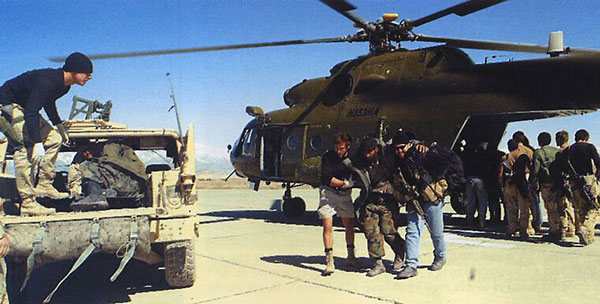 US special forces helping Northern Alliance troops away from a CIA-operated MI-17 Hip helicopter at Bagram Airbase, 2002 On September 11, 2001, 19 Al-Qaeda members hijacked four passenger jets within the Northeastern United States in a series of coordinated terrorist attacks. Two planes crashed into the Twin Towers of the World Trade Center in New York City, the third into the Pentagon in Arlington County, Virginia, and the fourth inadvertently into a field near Shanksville, Pennsylvania. The attacks cost the lives of 2,996 people (including the 19 hijackers), caused the destruction of the Twin Towers, and damaged the western side of the Pentagon. Soon after 9/11, The New York Times released a story stating that the CIA's New York field office was destroyed in the wake of the attacks. According to unnamed CIA sources, while first responders, military personnel and volunteers were conducting rescue efforts at the World Trade Center site, a special CIA team was searching the rubble for both digital and paper copies of classified documents. This was done according to well-rehearsed document recovery procedures put in place after the Iranian takeover of the United States Embassy in Tehran in 1979. While the CIA insists that those who conducted the attacks on 9/11 were not aware that the agency was operating at 7 World Trade Center under the guise of another (unidentified) federal agency, this center was the headquarters for many notable criminal terrorism investigations. Though the New York field offices' main responsibilities were to monitor and recruit foreign officials stationed at the United Nations, the field office also handled the investigations of the August 1998 bombings of United States Embassies in East Africa and the October 2000 bombing of the USS Cole.[209] Despite the fact that the 9/11 attacks may have damaged the CIA's New York branch, and they had to loan office space from the US Mission to the United Nations and other federal agencies, there was an upside for the CIA.[209] In the months immediately following 9/11, there was a huge increase in the number of applications for CIA positions. According to CIA representatives that spoke with The New York Times, pre-9/11 the agency received approximately 500 to 600 applications a week, in the months following 9/11 the agency received that number daily.[210] The intelligence community as a whole, and especially the CIA, were involved in presidential planning immediately after the 9/11 attacks. In his address to the nation at 8:30pm on September 11, 2001, George W. Bush mentioned the intelligence community: "The search is underway for those who are behind these evil acts, I've directed the full resource of our intelligence and law enforcement communities to find those responsible and bring them to justice."[211] The involvement of the CIA in the newly coined "War on Terror" was further increased on September 15, 2001. During a meeting at Camp David George W. Bush agreed to adopt a plan proposed by CIA director George Tenet. This plan consisted of conducting a covert war in which CIA paramilitary officers would cooperate with anti-Taliban guerrillas inside Afghanistan. They would later be joined by small special operations forces teams which would call in precision airstrikes on Taliban and Al Qaeda fighters. This plan was codified on September 16, 2001, with Bush's signature of an official Memorandum of Notification that allowed the plan to proceed.[212] 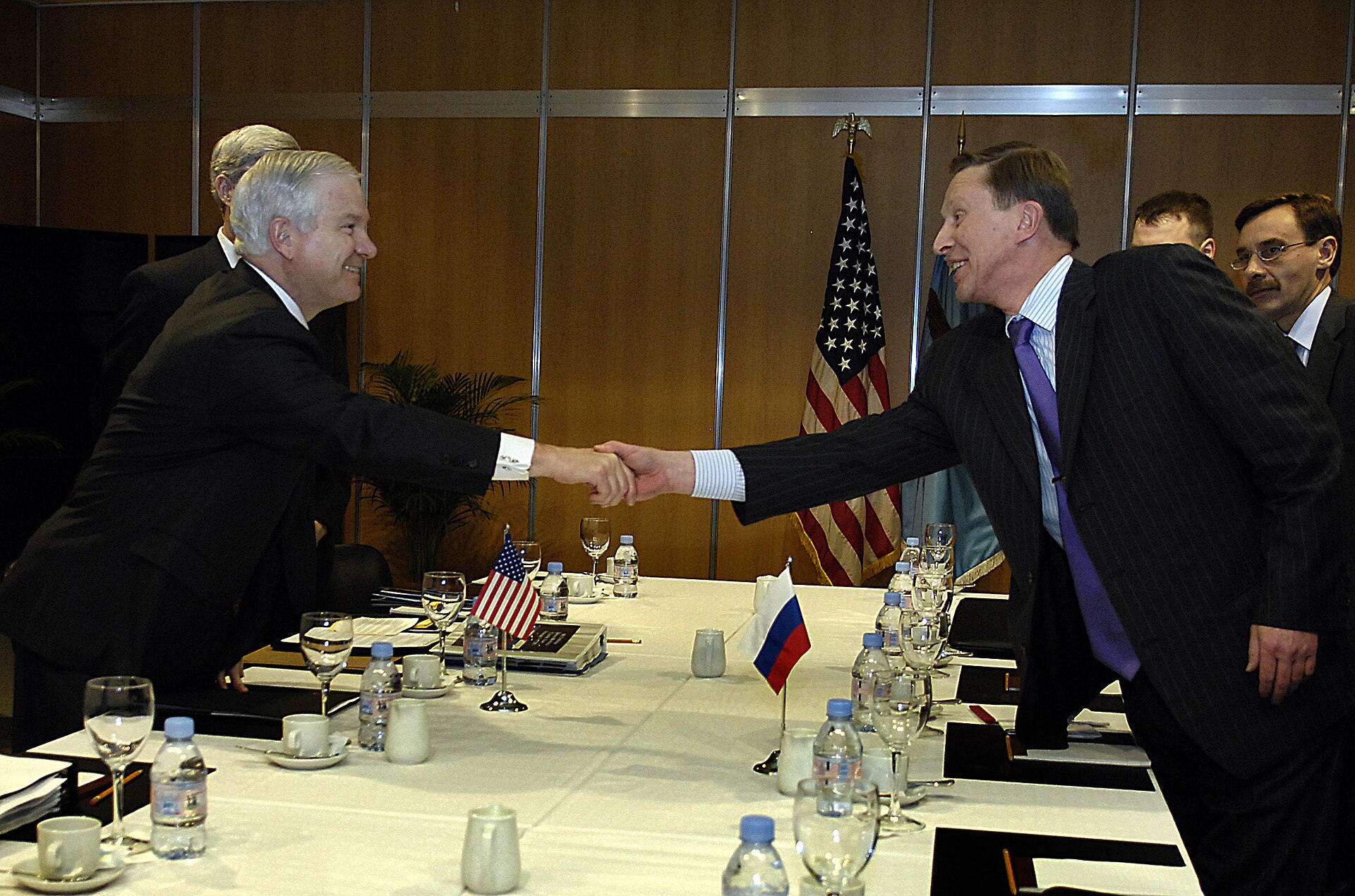 US Secretary of Defense and former Director of Central Intelligence Robert Gates meeting with Russian Minister of Defense and ex-KGB officer Sergei Ivanov, 2007 On November 25–27, 2001, Taliban prisoners revolted at the Qala Jangi prison west of Mazar-e-Sharif. Though several days of struggle occurred between the Taliban prisoners and the Northern Alliance members present, the prisoners gained the upper hand and obtained North Alliance weapons. At some point during this period Johnny "Mike" Spann, a CIA officer sent to question the prisoners, was beaten to death. He became the first American to die in combat in the war in Afghanistan.[212] After 9/11, the CIA came under criticism for not having done enough to prevent the attacks. Tenet rejected the criticism, citing the agency's planning efforts especially over the preceding two years. He also considered that the CIA's efforts had put the agency in a position to respond rapidly and effectively to the attacks, both in the "Afghan sanctuary" and in "ninety-two countries around the world".[213][214] The new strategy was called the "Worldwide Attack Matrix".[215] Anwar al-Awlaki, a Yemeni American U.S. citizen and al-Qaeda member, was killed on September 30, 2011, by a CIA drone strike in Yemen.[216][217] Al-Awlaki's 16-year-old son, a noncombatant and U.S. citizen, was also killed in a separate strike.[217] Although approved by the Department of Justice, the strikes sparked discussion on the legality of killing American citizens without trial.[216] |
9月11日の同時多発テロとその余波 2002年、バグラム空軍基地で、CIAが運用するMI-17ヒップヘリコプターから、北同盟軍を救助する米特殊部隊。 2001年9月11日、アルカイダのメンバー19人が、米国北東部で4機の旅客機をハイジャックし、一連の同時多発テロ攻撃を行った。2機はニューヨーク 市の世界貿易センタービルに、3機目はバージニア州アーリントン郡の国防総省に、4機目はペンシルベニア州シャンクスビル近くの田園地帯に不時着した。こ の攻撃により、2,996人(ハイジャック犯19人を含む)が死亡し、世界貿易センタービルは全壊、国防総省は西側が破壊された。9月11日の直後、 ニューヨーク・タイムズは、CIAのニューヨーク支局が攻撃の余波で破壊されたと報じた。CIAの匿名筋によると、救助活動を行う消防士、軍人、ボラン ティアがワールドトレードセンター現場で救助活動を行う中、CIAの特殊チームが瓦礫の中から機密文書のデジタルデータと紙のコピーを捜索していた。これ は、1979年にテヘランのアメリカ大使館がイランに占拠された後に策定された、よく練られた文書回収手順に従って行われた。 CIAは、9月11日の攻撃を実行した者たちは、同機関が別の(未特定)連邦機関を装って7ワールドトレードセンターで活動していたことを知らなかったと 主張しているが、このセンターは多くの著名なテロリズム捜査の本部だった。ニューヨークの現地事務所は、国連に駐在する外国政府高官の監視と採用を主な任 務としていたが、1998年8月の東アフリカにおける米国大使館爆破事件、2000年10月の米海軍艦艇コール号爆破事件の捜査も担当していた。 [209] 9.11 攻撃により CIA のニューヨーク支局が被害を受け、米国国連代表部や他の連邦機関から事務所を借り受けなければならなかったにもかかわらず、CIA にはメリットもあった。[209] 9.11 直後の数ヶ月間、CIA の採用応募者数が大幅に増加した。ニューヨーク・タイムズ紙と話をしたCIAの代表者によると、9/11以前は、CIAには週に約500から600件の応 募があったが、9/11後の数ヶ月間は、その数が毎日あったという。[210] 9/11攻撃直後、諜報機関全体、特にCIAは、大統領の計画に関与していた。2001年9月11日午後8時30分、ジョージ・W・ブッシュは国民に向け た演説で、諜報機関について次のように述べた。「この悪質な行為の黒幕の捜索は進行中だ。私は、諜報機関と法執行機関のあらゆる資源を動員して、責任者を 突き止め、法の下に裁きにかけるよう指示した」[211]。 2001年9月15日、新たに「対テロ戦争」と命名された戦争へのCIAの関与はさらに深まった。キャンプ・デービッドでの会議で、ジョージ・W・ブッ シュは、CIA長官ジョージ・テネットが提案した計画を採用することに合意した。この計画は、CIAの準軍事組織がアフガニスタン国内の反タリバンゲリラ と協力し、秘密戦争を行うというものであった。その後、この部隊には小規模の特殊作戦部隊が加わり、タリバンやアルカイダの戦闘員に対して精密空爆を行う ことになっていた。この計画は、2001年9月16日、ブッシュ大統領が計画の実施を承認する公式の通知書(Memorandum of Notification)に署名して、正式に決定された。[212]  2007年、ロバート・ゲイツ米国防長官(元中央情報局(CIA)長官)とセルゲイ・イワノフロシア国防相(元 KGB 職員)との会談 2001年11月25日から27日にかけて、マザリシャリフ西部のカラジャンギ刑務所で、タリバン囚人が反乱を起こした。タリバン囚人と現場にいた北部同 盟のメンバーとの間で数日間の闘争が続いたが、囚人が優勢となり、北部同盟の武器を入手した。この期間のある時点で、囚人の尋問のために派遣されたCIA 職員ジョニー・「マイク」・スパンが殴打され、死亡した。彼は、アフガニスタン戦争で戦闘中に死亡した最初のアメリカ人となった。 9.11 以降、CIA は、攻撃の防止に十分な対応をとらなかったとして批判を受けた。テネットは批判を拒否し、特に前2年間の計画努力を理由に挙げた。また、CIAの努力が、 アフガニスタンの「聖域」と「世界92カ国」の両方で、攻撃に迅速かつ効果的に対応できる立場にCIAを置いたと考えた。[213][214] 新戦略は「ワールドワイド・アタック・マトリックス」と名付けられた。[215] イエメン系アメリカ人でアルカイダメンバーのアンワル・アル=アウラキは、2011年9月30日、イエメンでCIAのドローン攻撃により殺害された。 [216][217] アウラキの16歳の息子(非戦闘員でアメリカ市民)も、別の攻撃で殺害された。[217] 司法省によって承認されたものの、これらの攻撃は、裁判なしにアメリカ市民を殺害する合法性に関する議論を巻き起こした。[216] |
| Failures in intelligence analysis A major criticism is a failure to forestall the September 11 attacks. The 9/11 Commission Report identified failures in the IC as a whole. One problem, for example, was the FBI failing to "connect the dots" by sharing information among its decentralized field offices. The report concluded that former DCI George Tenet failed to adequately prepare the agency to deal with the danger posed by al-Qaeda prior to the attacks of September 11, 2001.[218] The report was finished in June 2005 and was partially released to the public in an agreement with Congress, over the objections of current DCI General Michael Hayden. Hayden said its publication would "consume time and attention revisiting ground that is already well plowed."[219] Tenet disagreed with the report's conclusions, citing his planning efforts vis-à-vis al-Qaeda, particularly from 1999.[220] Assistant Secretary of State for Intelligence, Carl W. Ford Jr. remarked, "As long as we rate intelligence more for its volume than its quality, we will continue to turn out the $40 billion pile of crap we have become famous for." He further stated, "[The CIA is] broken. It's so broken that nobody wants to believe it."[221] |
情報分析の失敗 大きな批判の一つは、9月11日の攻撃を未然に防げなかったことだ。9.11委員会報告書は、情報機関全体における失敗を指摘している。例えば、FBIが分散した現地事務所間で情報を共有できず、「点と点を結びつける」ことができなかったことが問題の一つだった。 報告書は、元CIA長官ジョージ・テネットが、2001年9月11日の攻撃前にアルカイダがもたらす危険に対処するための機関の準備を十分に整えなかった と結論付けた。[218] 報告書は2005年6月に完成し、当時のCIA長官マイケル・ヘイデン将軍の反対にもかかわらず、議会との合意に基づき一部が一般公開された。ヘイデン は、この報告書の公表は「すでに十分に検討された事柄を再検討するために時間と注意を費やすことになる」と述べた[219]。テネットは、特に 1999 年以降のアルカイダに対する計画的な取り組みを理由に、報告書の結論に同意しなかった[220]。情報担当国務次官のカール・W・フォード・ジュニアは、 「情報評価の質よりも量で評価し続ける限り、我々は、我々が有名になった 400 億ドルのくだらない情報という結果を生み出し続けるだろう」と述べた。フォード・ジュニアは、「情報機関が情報の量よりも質を重視する限り、私たちは $400億のゴミの山を生み出し続けるだろう」と述べた。さらに、「CIAは壊れている。壊れすぎて、誰もそれを信じたくないほどだ」と付け加えた。 [221] |
| Yugoslav wars See also: Breakup of Yugoslavia In 1989; Yugoslavia officially dissolved into six republics, with borders drawn along ethnic and historical lines: Bosnia and Herzegovina, Croatia, Macedonia, Montenegro, Serbia, and Slovenia. This quickly dissolved into ethnic tensions between Serbs and other Balkan ethnicities. In 1991, the CIA predicted that tension in the region would evolve into a full blown Civil war.[222] In 1992, the U.S. embargoed the trafficking of weapons into both Bosnia and Serbia in order to not prolong the war and the destruction of impacted communities. In May 1994, the CIA reported that the embargo had been ignored by countries such as Malaysia and Iran who moved weapons into Bosnia.[223] |
ユーゴスラビア戦争 関連項目:ユーゴスラビアの解体 1989年、ユーゴスラビアは、民族や歴史的な境界線に沿って、ボスニア・ヘルツェゴビナ、クロアチア、マケドニア、モンテネグロ、セルビア、スロベニア の6つの共和国に正式に解体された。これはすぐにセルビア人と他のバルカン民族間の民族対立に発展した。1991年、CIAは、この地域の緊張が全面的な 内戦に発展すると予測した。[222] 1992年、米国は戦争の長期化と影響を受けたコミュニティの破壊を防止するため、ボスニアとセルビアへの武器の密輸を禁止した。1994年5月、CIA は、マレーシアやイランなどの国々が武器をボスニアに密輸し、禁輸措置が無視されていると報告した。[223] |
| Iraq War Main article: CIA activities in Iraq Further information: Plame affair Seventy-two days after the 9/11 attacks, President Bush told Secretary of Defense Rumsfeld to update the US plan for an invasion of Iraq, but not to tell anyone. Rumsfeld asked Bush if he could bring DCI Tenet into the loop, to which Bush agreed.[224] The CIA had put eight of their best officers in Kurdish territory in Northern Iraq. By December 2002, the CIA had close to a dozen functional networks in Iraq[224]: 242 and would penetrate Iraq's SSO, tap the encrypted communications of the Deputy Prime Minister, and recruit the bodyguard of Hussein's son[which?] as an agent. As time passed, the CIA would become more frantic about the possibility of their networks being compromised. To the CIA, the invasion had to occur before the end of February 2003 if their sources inside Hussein's government were to survive. The rollup would happen as predicted; 37 CIA sources recognized by their Thuraya satellite telephones provided for them by the CIA.[224]: 337  Former CIA deputy director Michael Morell apologized to Colin Powell for the CIA's erroneous assessments of Iraq's WMD programs.[225] The case Colin Powell presented before the United Nations (purportedly proving an Iraqi WMD program) was inaccurate. DDCI John E. McLaughlin was part of a long discussion in the CIA about equivocation. McLaughlin, who would make, among others, the "slam dunk" presentation to the President, "felt that they had to dare to be wrong to be clearer in their judgments".[224]: 197 The Al Qaeda connection, for instance, was from a single source, extracted through torture, and was later denied. The sole source for the allegations of Iraqi mobile weapons laboratories, code-named Curveball, was a known liar.[226] A postmortem of the intelligence failures in the lead up to Iraq led by former DDCI Richard Kerr would conclude that the CIA had been a casualty of the Cold War, wiped out in a way "analogous to the effect of the meteor strikes on the dinosaurs."[227] 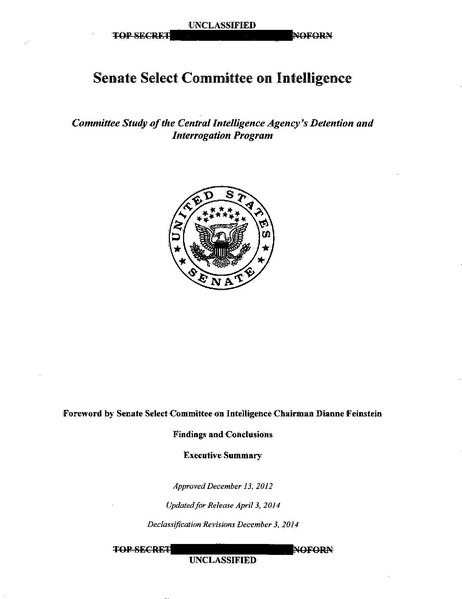 The Senate Intelligence Committee report on CIA torture that details the use of torture during CIA detention and interrogation The opening days of the invasion of Iraq would see successes and defeats for the CIA. With its Iraq networks compromised, and its strategic and tactical information shallow, and often wrong, the intelligence side of the invasion itself would be a black eye for the agency. The CIA would see some success with its "Scorpion" paramilitary teams composed of CIA Special Activities Division paramilitary officers, along with friendly Iraqi partisans. CIA SAD officers would also help the US 10th Special Forces.[224][228][229] The occupation of Iraq would be a low point in the history of the CIA. At the largest CIA station in the world, officers would rotate through 1–3-month tours. In Iraq, almost 500 transient officers would be trapped inside the Green Zone while Iraq station chiefs would rotate with only a little less frequency.[230] |
イラク戦争 主な記事:CIAのイラクでの活動 詳細情報:プレイム事件 9.11 攻撃から 72 日後、ブッシュ大統領はラムズフェルド国防長官に、イラク侵攻の計画を更新するよう指示したが、そのことを誰にも漏らさないよう指示した。ラムズフェルド は、テネット CIA 長官をその計画に組み込むことをブッシュ大統領に打診し、ブッシュ大統領はそれを承認した[224]。 CIAは、イラク北部のクルド人地域に8人の精鋭工作員を派遣していた。2002年12月までに、CIAはイラク国内に12の機能的なネットワークを構築 し[224]: 242、イラクのSSOに潜入し、副首相の暗号通信を傍受し、フセインの息子のボディガード[どの息子?]をスパイとして採用した。時が 経つにつれ、CIA は、ネットワークが危険にさらされている可能性について、ますます焦りを感じていた。CIA にとって、フセイン政権内の情報源を生き残らせるためには、2003 年 2 月末までに侵攻を開始しなければならなかった。予想通り、CIA が提供したトゥラヤ衛星電話によって 37 人の CIA 情報源が特定された。[224]: 337  元CIA副長官のマイケル・モレルは、イラクの大規模破壊兵器プログラムに関するCIAの誤った評価について、コリン・パウエルに謝罪した。 コリン・パウエルが国連で発表した(イラクの大規模破壊兵器プログラムの存在を証明するはずだった)資料は不正確だった。DDCI のジョン・E・マクラフリンは、CIA 内で曖昧な表現について長時間の議論に参加した。大統領に対して「スラムダンク」と評されたプレゼンテーションを行ったマクラフリンは、「判断をより明確 にするためには、間違っていることを敢えて指摘しなければならない」と感じていた。[224]: 197 例えば、アルカイダとの関連は、拷問によって引き出された単一の情報源によるものであり、後に否定された。イラクの移動式兵器研究所に関する主張の唯一の ソースは、コードネーム「カーブボール」と呼ばれる既知の嘘つきだった。[226] イラク侵攻前の情報失敗に関する元DDCIリチャード・カーが主導した事後検証は、CIAが冷戦の犠牲となり、「恐竜に隕石が衝突した効果に類似した」方 法で壊滅したと結論付けた。[227]  CIAの拷問に関する上院情報委員会報告書は、CIAの拘禁と尋問における拷問の使用を詳細に記述している。 イラク侵攻の初期段階では、CIAは成功と失敗を経験した。イラクのネットワークが崩壊し、戦略的・戦術的な情報が浅く、しばしば誤っていたため、侵攻そ のものの情報収集は、機関にとって大きな失態となった。CIAは、CIA特殊活動部(SAD)の特殊部隊員と友好的なイラクのパルチザンで構成される「ス コーピオン」特殊部隊で一部成功を収めた。CIA SADの特殊部隊員は、米軍第10特殊部隊の支援も行った。[224][228][229] イラク占領は、CIAの歴史における低調期となった。世界最大のCIA拠点では、職員が1~3ヶ月の任期で交代で勤務していた。イラクでは、ほぼ500人 の一時的な職員がグリーンゾーン内に閉じ込められ、イラク拠点の責任者はやや短い周期で交代していた。[230] |
| 2004, DNI takes over CIA top-level functions The Intelligence Reform and Terrorism Prevention Act of 2004 created the office of the Director of National Intelligence (DNI), who took over some of the government and intelligence community (IC)-wide functions that had previously been the CIA's.[231] The DNI manages the United States Intelligence Community and in so doing it manages the intelligence cycle. Among the functions that moved to the DNI were the preparation of estimates reflecting the consolidated opinion of the 16 IC agencies, and preparation of briefings for the president. On July 30, 2008, President Bush issued Executive Order 13470[232] amending Executive Order 12333 to strengthen the role of the DNI.[233] Previously, the Director of Central Intelligence (DCI) oversaw the Intelligence Community, serving as the president's principal intelligence advisor, additionally serving as head of the CIA. The DCI's title now is "Director of the Central Intelligence Agency" (D/CIA), serving as head of the CIA. Currently, the CIA reports to the Director of National Intelligence. Before the establishment of the DNI, the CIA reported to the President, with informational briefings to congressional committees. The National Security Advisor is a permanent member of the National Security Council, responsible for briefing the President with pertinent information collected by all U.S. intelligence agencies, including the National Security Agency, the Drug Enforcement Administration, etc. All 16 Intelligence Community agencies are under the authority of the Director of National Intelligence. |
2004年、DNI が CIA の最高レベルの機能を引き継ぐ 2004年の情報改革およびテロ防止法により、国家情報長官(DNI)の職が創設され、これまで CIA が担っていた政府および情報コミュニティ(IC)全体の機能の一部を引き継いだ。[231] DNI は、米国情報コミュニティを管理し、その一環として情報サイクルを管理している。DNIに移管された機能には、16のIC機関の統合された見解を反映した 見積書の作成、および大統領向けのブリーフィングの作成が含まれる。2008年7月30日、ブッシュ大統領は大統領令13470[232]を発令し、大統 領令12333を改正してDNIの役割を強化した。[233] 以前は、中央情報局長官(DCI)が情報コミュニティを監督し、大統領の主要な情報顧問を務めるとともに、CIAの長官も兼任していた。DCIの現在の職名は「中央情報局長官」(D/CIA)で、CIAの長官を務める。 現在、CIA は国家情報長官に直属している。DNI が設立される以前は、CIA は大統領に直属し、議会委員会に情報報告を行っていた。国家安全保障問題担当大統領補佐官は、国家安全保障会議の常任メンバーであり、国家安全保障局、麻 薬取締局など、米国のすべての情報機関が収集した関連情報を大統領に報告する責任がある。16 の情報機関はすべて、国家情報長官の権限下にある。 |
| Operation Neptune Spear See also: Death of Osama bin Laden On May 1, 2011, President Barack Obama announced that Osama bin Laden was killed earlier that day by "a small team of Americans" operating in Abbottabad, Pakistan, during a CIA operation.[234][235] The raid was executed from a CIA forward base in Afghanistan by elements of the U.S. Navy's Naval Special Warfare Development Group and CIA paramilitary operatives.[236] The operation was a result of years of intelligence work that included the CIA's capture and interrogation of Khalid Sheik Mohammad, which led to the identity of a courier of bin Laden's,[237][238][239] the tracking of the courier to the compound by Special Activities Division paramilitary operatives and the establishing of a CIA safe house to provide critical tactical intelligence for the operation.[240][241][242] The CIA ran a fake vaccination clinic in an attempt to locate Osama bin Laden. This may have negatively affected the campaign against polio in Pakistan and Afghanistan. In some rural areas, vaccination workers were banned by the Taliban or chased away by locals.[243][244] There have been many deadly attacks by militants against vaccination workers in Pakistan.[245] Efforts to eradicate polio have furthermore been disrupted by American drone strikes.[243] |
ネプチューン・スピア作戦 関連項目:オサマ・ビンラーディンの死 2011年5月1日、バラク・オバマ大統領は、その日早朝、パキスタンのアボタバードでCIAの作戦により「少人数のアメリカ人部隊」によってオサマ・ビ ンラディンが殺害されたと発表した。[234][235] この襲撃は、アフガニスタンのCIA前線基地から、米海軍特殊戦開発グループ(SEAL Team 6)とCIAの特殊部隊によって実行された。[236] この作戦は、CIAがカリド・シェイク・モハメドを捕獲・尋問し、ビンラディンの連絡員の身元を特定したこと[237][238][239]、特殊活動部 (SAD)の準軍事要員が連絡員を複合施設まで追跡したこと、および作戦のための重要な戦術情報を提供するCIAの安全屋を設置したことなど、数年にわた る諜報活動の成果だった。[240][241][242] CIAは、オサマ・ビン・ラディンを特定するため、偽のワクチン接種クリニックを運営した。これは、パキスタンとアフガニスタンでのポリオ対策キャンペー ンに悪影響を及ぼした可能性がある。一部の農村部では、タリバンによってワクチン接種従事者が禁止されたり、地元住民に追放されたりした。[243] [244] パキスタンでは、ワクチン接種従事者に対する武装勢力の攻撃が数多く発生している。[245] ポリオ根絶の努力は、さらにアメリカのドローン攻撃によって妨害されている。[243] |
| Syrian Civil War Main article: CIA activities in Syria President Barack Obama and CIA Director John Brennan at the GCC-U.S. Summit in Riyadh in April 2016. Saudi Arabia was involved in the CIA-led Timber Sycamore covert operation. Under the aegis of operation Timber Sycamore and other clandestine activities, CIA operatives and U.S. special operations troops have trained and armed nearly 10,000 rebel fighters at a cost of $1 billion a year.[246] The CIA has been sending weapons to anti-government rebels in Syria since at least 2012.[247] These weapons have been reportedly falling into hands of extremists, such as al-Nusra Front and ISIL.[248][249][250] Around February 2017, the CIA was instructed to halt military aid to Syrian rebels (Free Syrian Army or FSA), which also included training, ammunition, guided missiles, and salaries. Sources believe that the aid freeze was related to concerns that weapons and funds will fall into the hands of ISIL. On April 6, 2017, Al-Jazeera reported that funding to the FSA was partially restored. Based on the information provided by two FSA sources, the new military operation room will receive its funds from the coalition "Friends of Syria." The coalition consists of members from the U.S., Turkey, Western Europe, and Gulf states, which previously supported the military operation known as MOM.[251] It was reported in July 2017 that President Donald Trump had ordered a "phasing out" of the CIA's support for anti-Assad rebels.[252] |
シリア内戦 主な記事:シリアにおけるCIAの活動 2016年4月、リヤドで開催されたGCC-米国首脳会議に出席したバラク・オバマ大統領とジョン・ブレナンCIA長官。サウジアラビアは、CIA主導の秘密作戦「ティンバー・シカモア」に関与していた。 ティンバー・シカモア作戦およびその他の秘密活動の下で、CIA工作員と米特殊部隊は、年間$10億の費用をかけて、約1万人の反政府戦闘員を訓練し武装 させた。[246] CIAは2012年以降、シリアの反政府勢力に武器を供給してきた。[247] これらの武器は、アル・ヌスラ戦線やISILなどの過激派の手に渡っているとの報告がある。[248][249][250] 2017年2月頃、CIAはシリアの反政府勢力(自由シリア軍またはFSA)への軍事援助(訓練、弾薬、誘導ミサイル、給与を含む)を停止するよう指示さ れた。情報筋は、この援助の凍結は、武器や資金が ISIL の手に渡ることを懸念したものだと考えている。2017年4月6日、アルジャジーラは、FSA への資金援助が一部再開されたと報じた。FSA の 2 つの情報筋によると、新しい軍事作戦室は、連合「シリアの友人たち」から資金援助を受けることになる。この連合は、MOM として知られる軍事作戦を以前支援していた米国、トルコ、西ヨーロッパ、湾岸諸国で構成されている[251]。 2017年7月、ドナルド・トランプ大統領が、反アサド反政府勢力に対する CIA の支援の「段階的廃止」を命じたと報じられた[252]。 |
| Reorganization On 6 March 2015, the office of the D/CIA issued an unclassified edition of a statement by the director, titled 'Our Agency's Blueprint for the Future', as a press release for public consumption. The press release announced sweeping plans for the reorganization and reform of the CIA, which the director believes will bring the CIA more in line with the Agency doctrine called the 'Strategic Direction'. Among the principal changes disclosed include the establishment of a new directorate, the Directorate of Digital Innovation. Other changes which were announced include the formation of a Talent Development Center of Excellence, the enhancement and expansion of the CIA University and the creation of the office of the Chancellor to head the CIA University in order to consolidate and unify recruitment and training efforts. The National Clandestine Service (NCS) will be reverting to its original Directorate name, the Directorate of Operations. The Directorate of Intelligence is also being renamed; it will now be the Directorate of Analysis.[253] Drones A new policy introduced by President Barack Obama removed the authority of the CIA to launch drone attacks and allowed these attacks only under Department of Defense command. This change was reversed by President Donald Trump, who authorized CIA drone strikes on suspected terrorists.[254] Encryption devices sold through front company For decades until 2018, the CIA secretly owned Crypto AG, a small Swiss company that made encryption devices, in association with West German intelligence. The company sold compromised encryption devices to over 120 countries, allowing Western intelligence to eavesdrop on communications that the users believed to be secure.[255][256] |
再編 2015年3月6日、D/CIA事務所は、局長による「Our Agency's Blueprint for the Future(私たちの機関の将来構想)」と題した非機密版の声明を、報道機関向けにプレスリリースとして発表した。このプレスリリースでは、CIAの局 長が、CIAを「戦略的方向性」と呼ばれる機関の方針により一層整合させるものとなる、CIAの再編と改革に関する抜本的な計画が発表された。公表された 主な変更点としては、新しい局であるデジタル・イノベーション局の設置が挙げられる。その他、人材開発センター・オブ・エクセレンス(Talent Development Center of Excellence)の設立、CIA 大学の強化・拡大、CIA 大学を統括する学長職の設置による採用と研修の統合・統一などが発表されている。国家秘密情報局(NCS)は、元の局名である作戦局 (Directorate of Operations)に戻ることになる。情報局も名称が変更され、分析局となる。[253] ドローン バラク・オバマ大統領が導入した新しい政策により、CIA はドローン攻撃を行う権限を剥奪され、国防総省の指揮下でのみ攻撃を行うことが許可された。この変更は、テロ容疑者に対する CIA のドローン攻撃を承認したドナルド・トランプ大統領によって覆された。[254] ダミー会社を通じて販売された暗号化装置 2018年までの数十年間、CIA は西ドイツの諜報機関と提携し、暗号化装置を製造するスイスの小さな企業 Crypto AG を秘密裏に所有していた。この企業は、120 以上の国に暗号化装置を販売し、西側の諜報機関が、ユーザーが安全だと信じていた通信を盗聴することを可能にした。[255][256] |
| https://en.wikipedia.org/wiki/Central_Intelligence_Agency |
リ ンク
文 献
そ の他の情報
CC
Copyleft, CC, Mitzub'ixi Quq Chi'j, 1996-2099
☆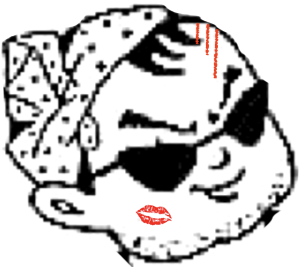
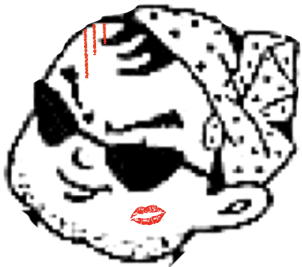 ☆
☆